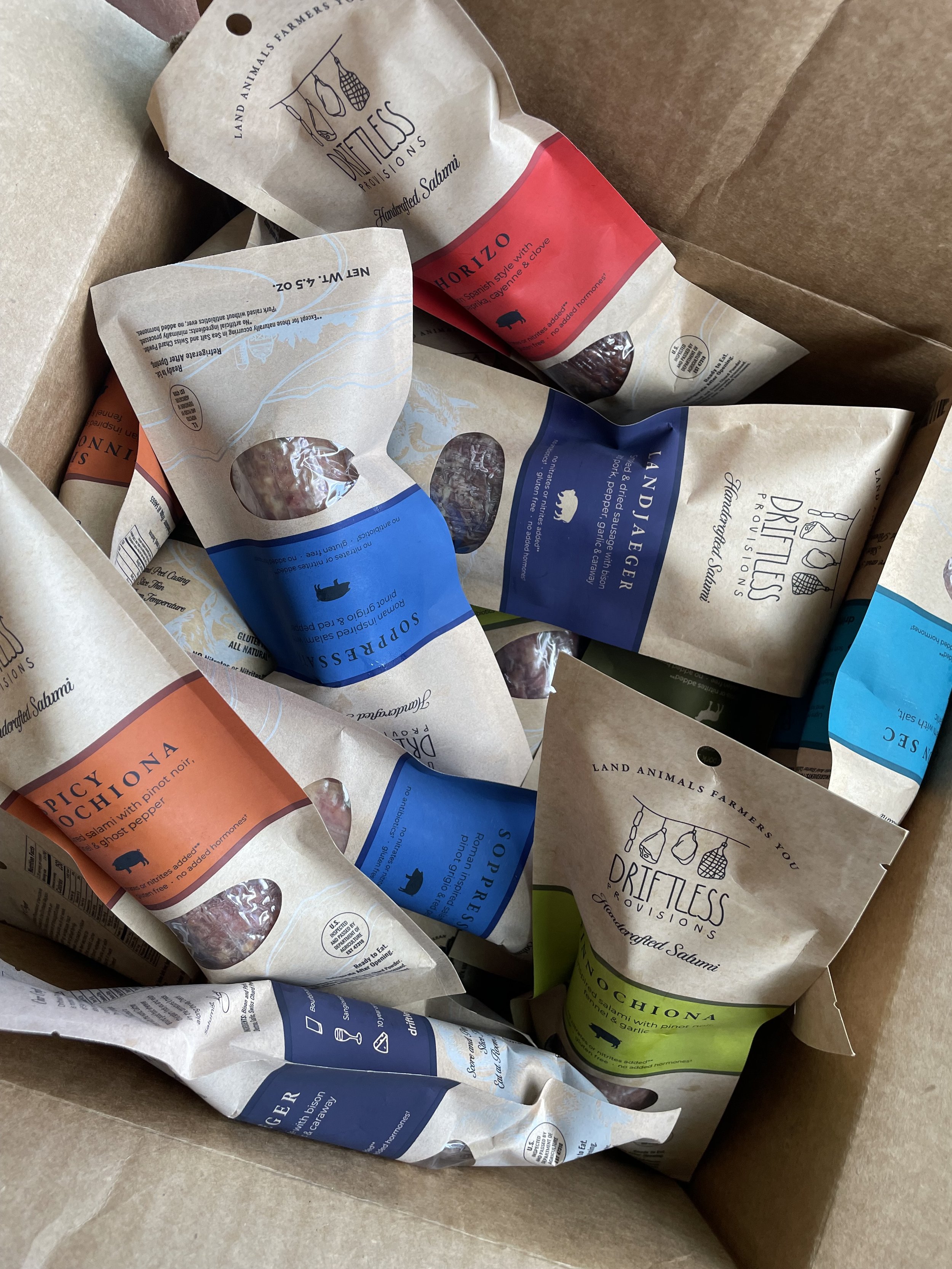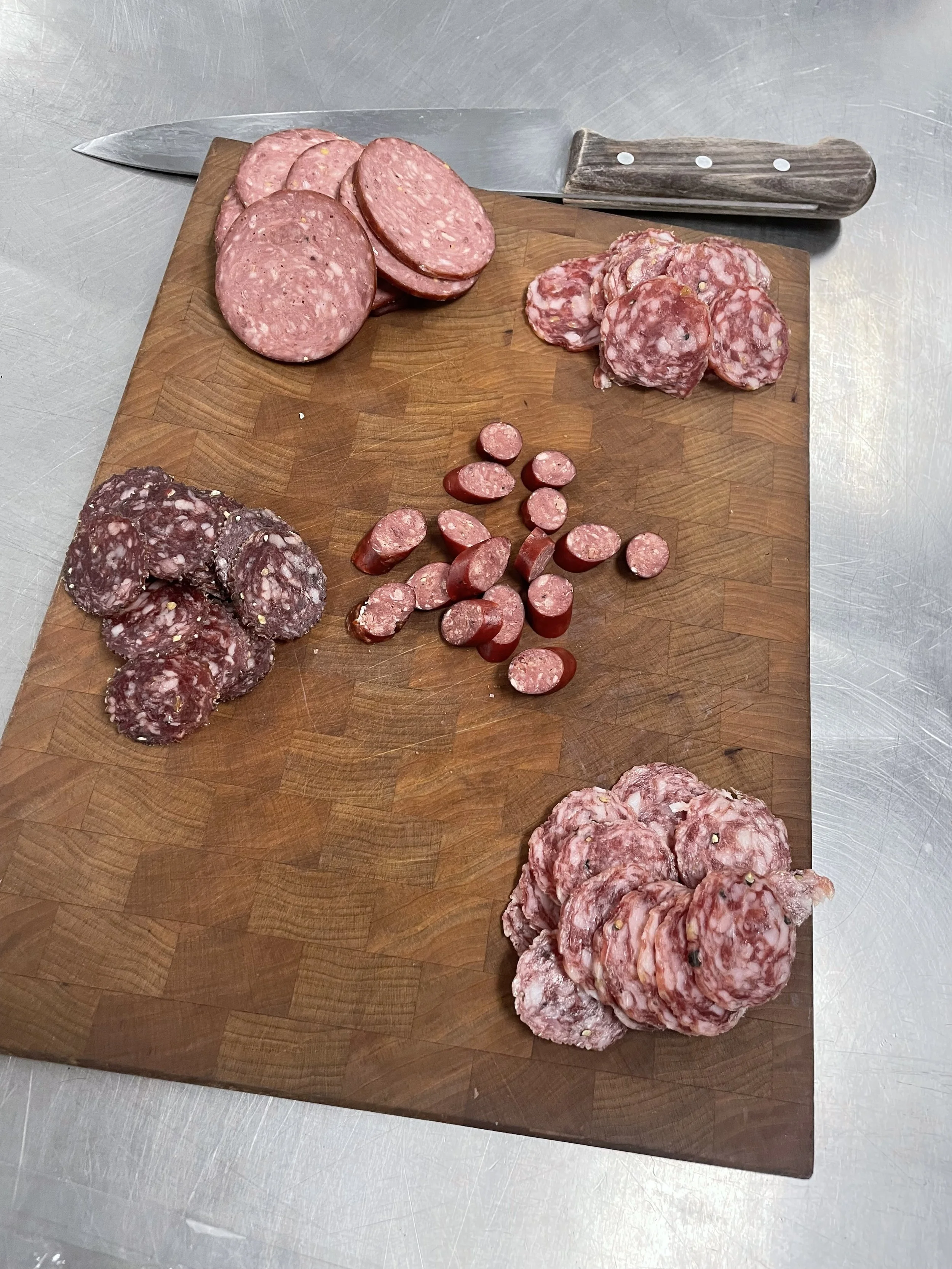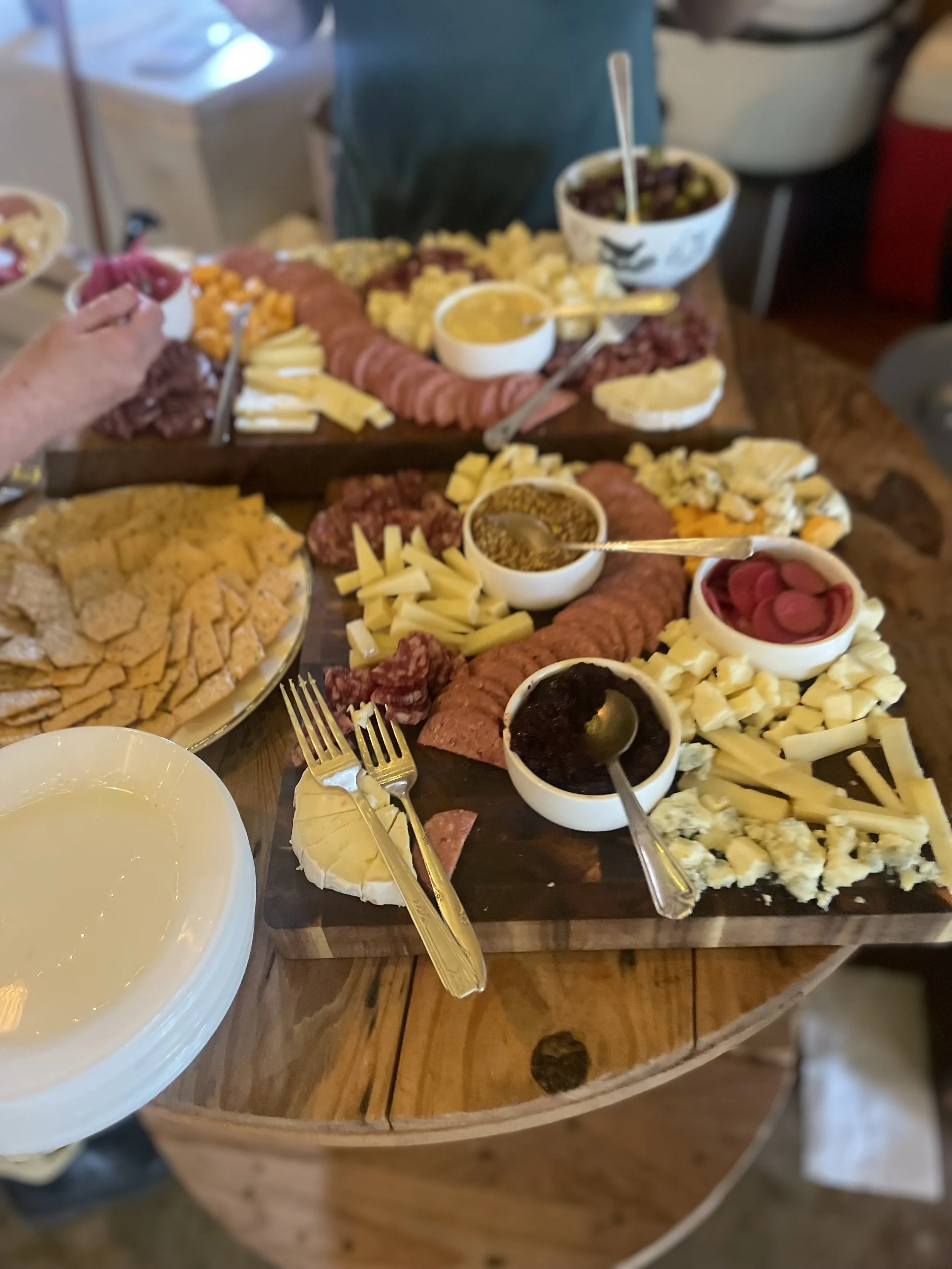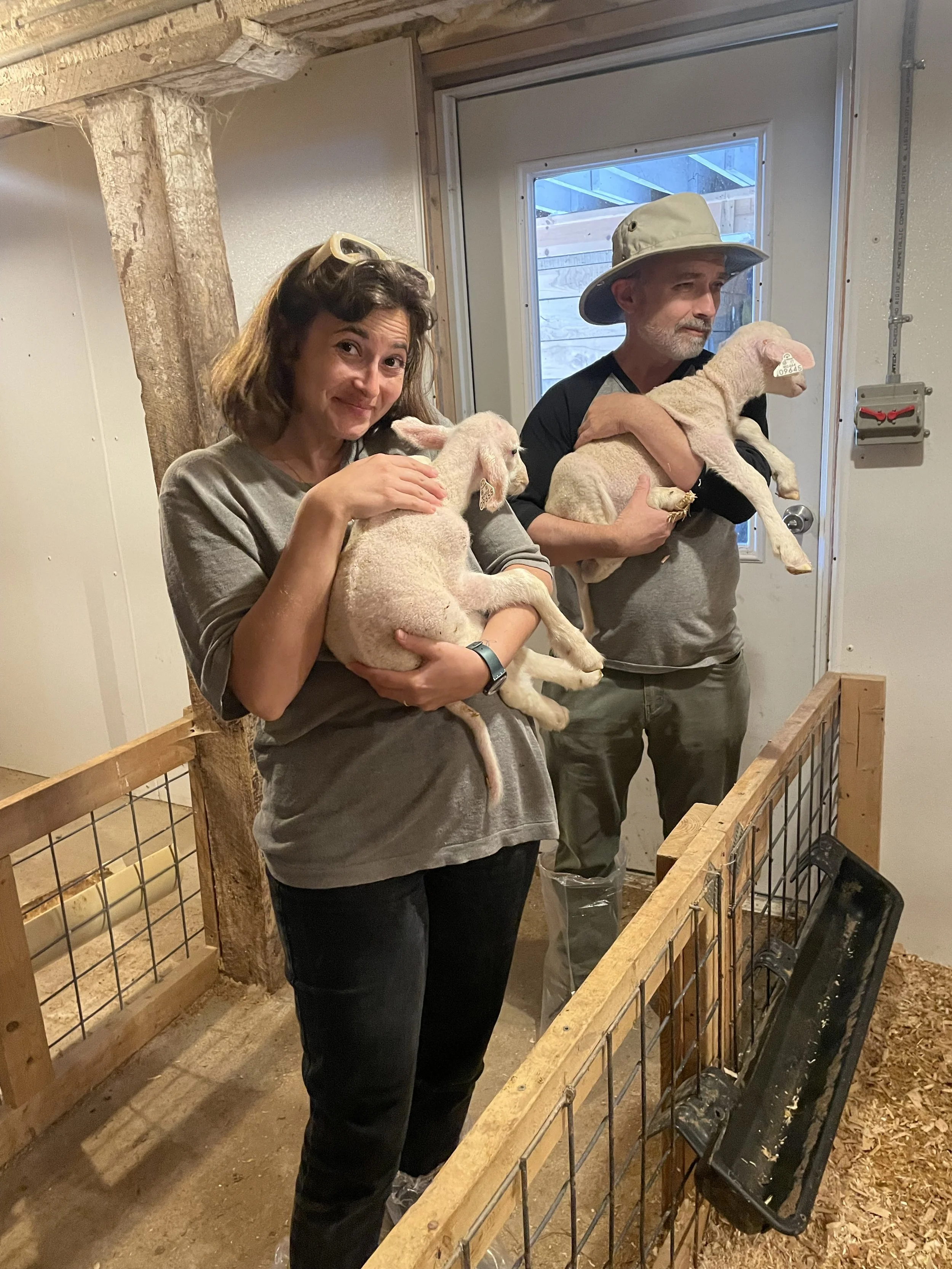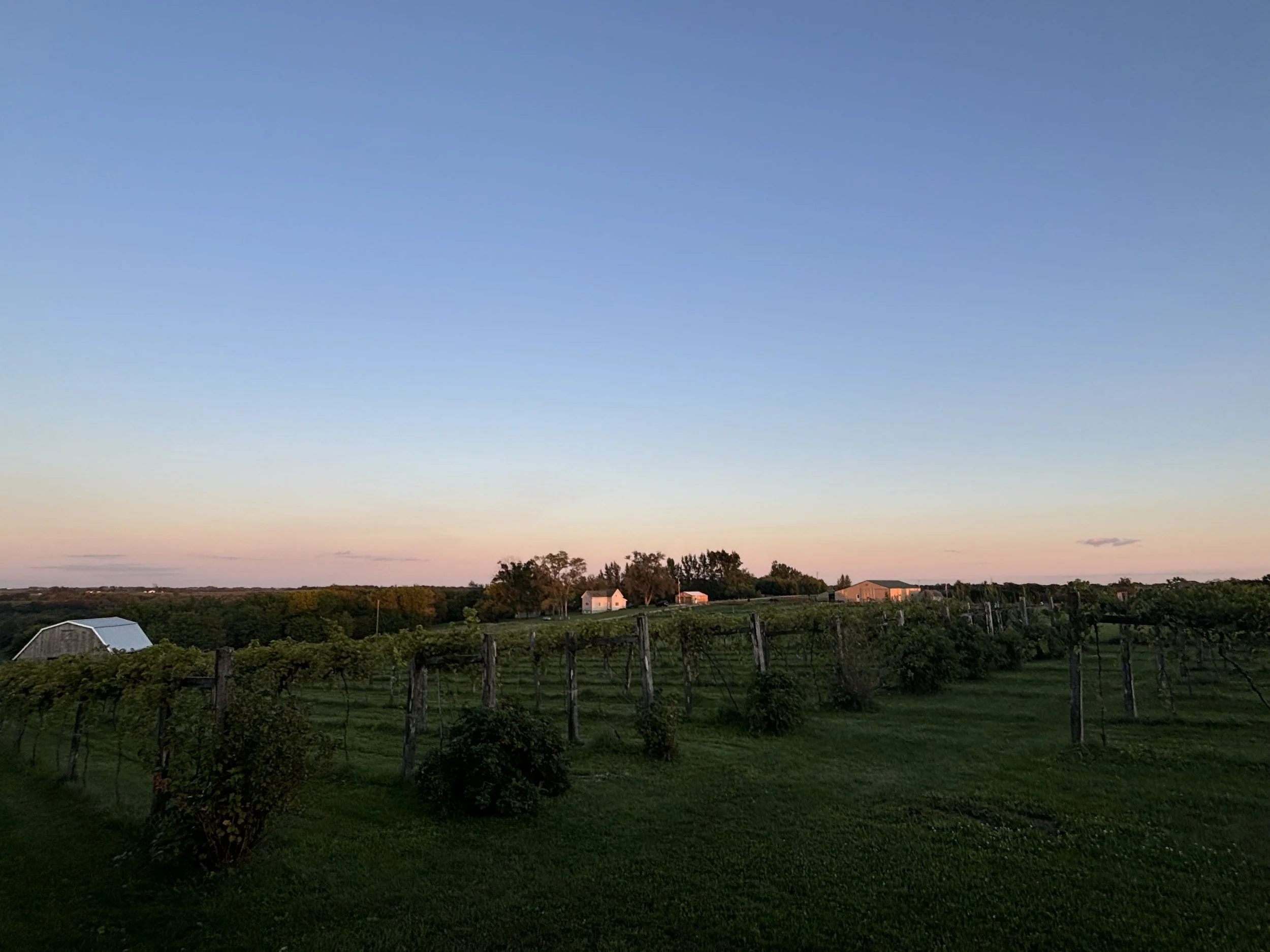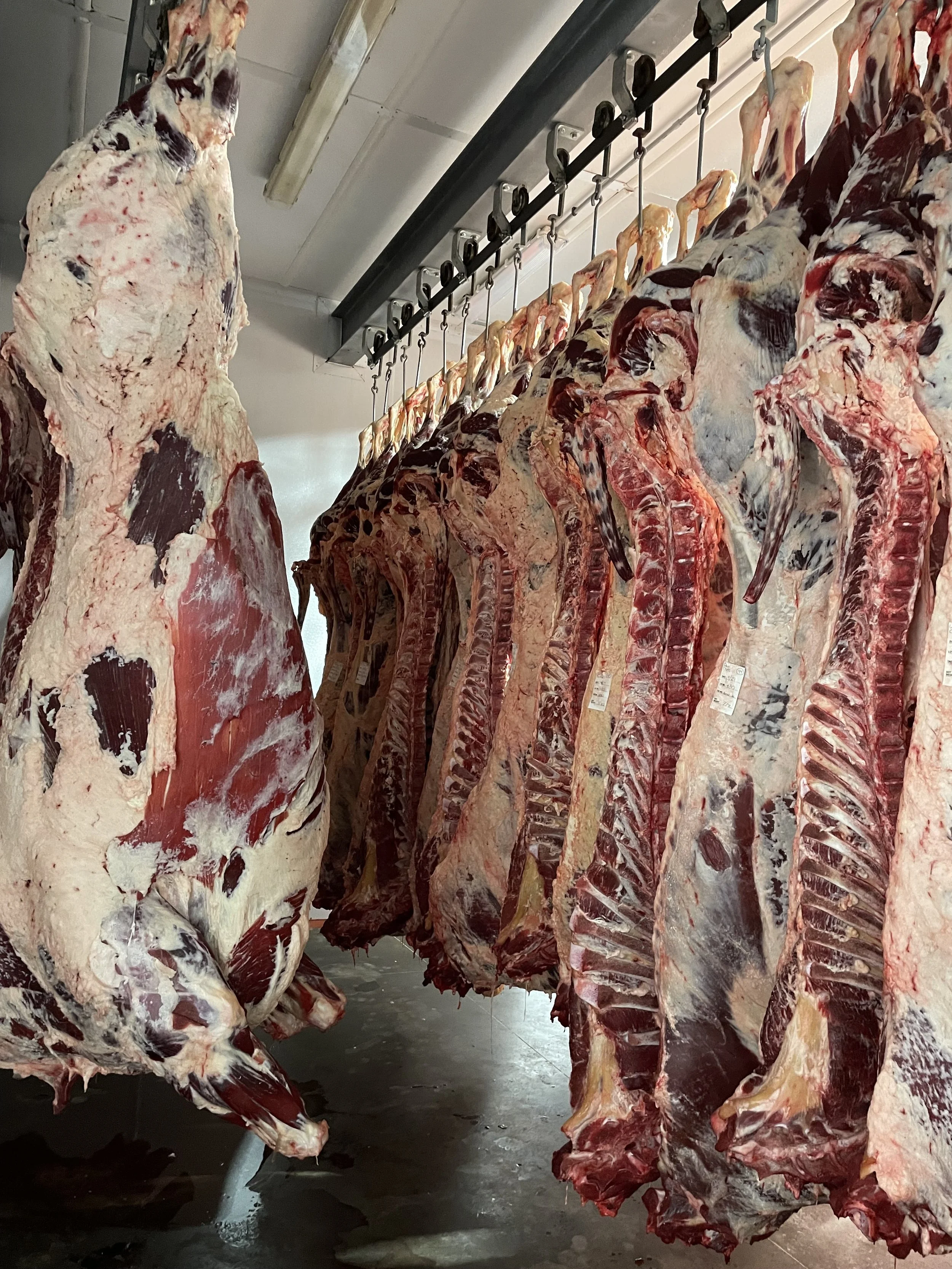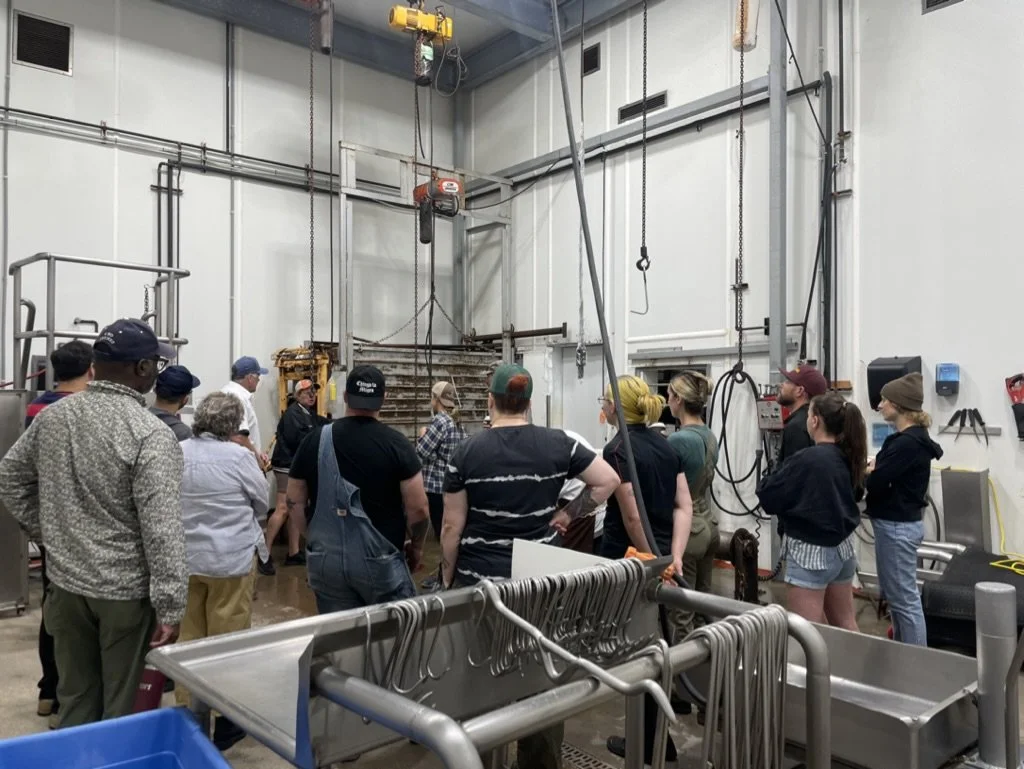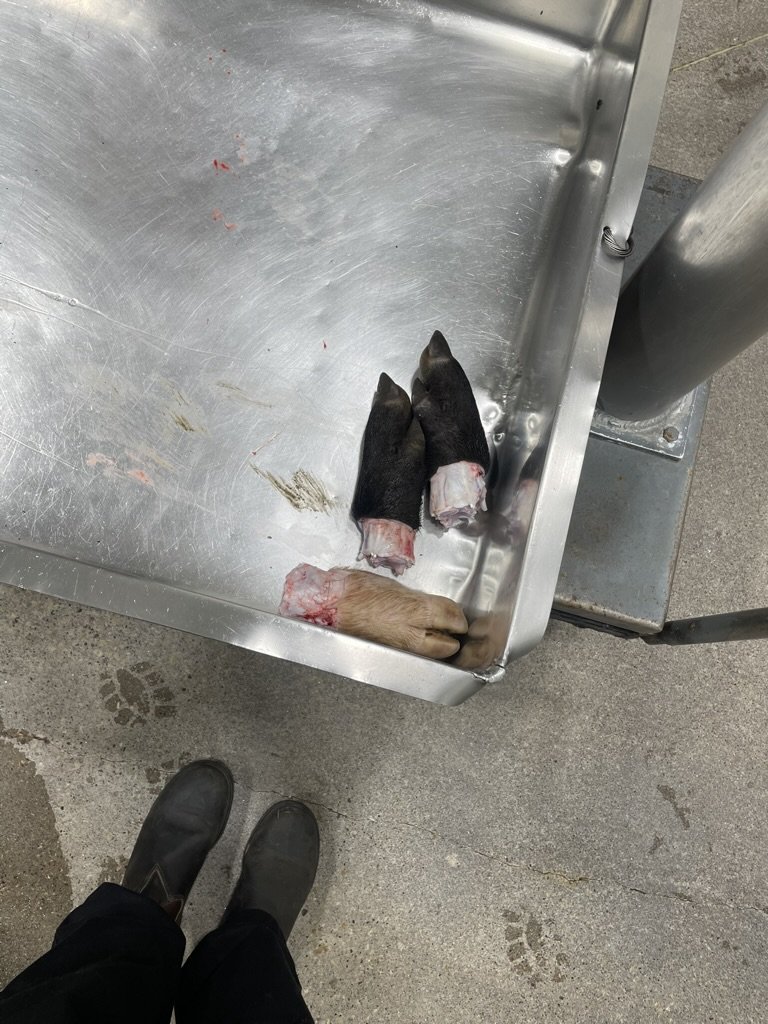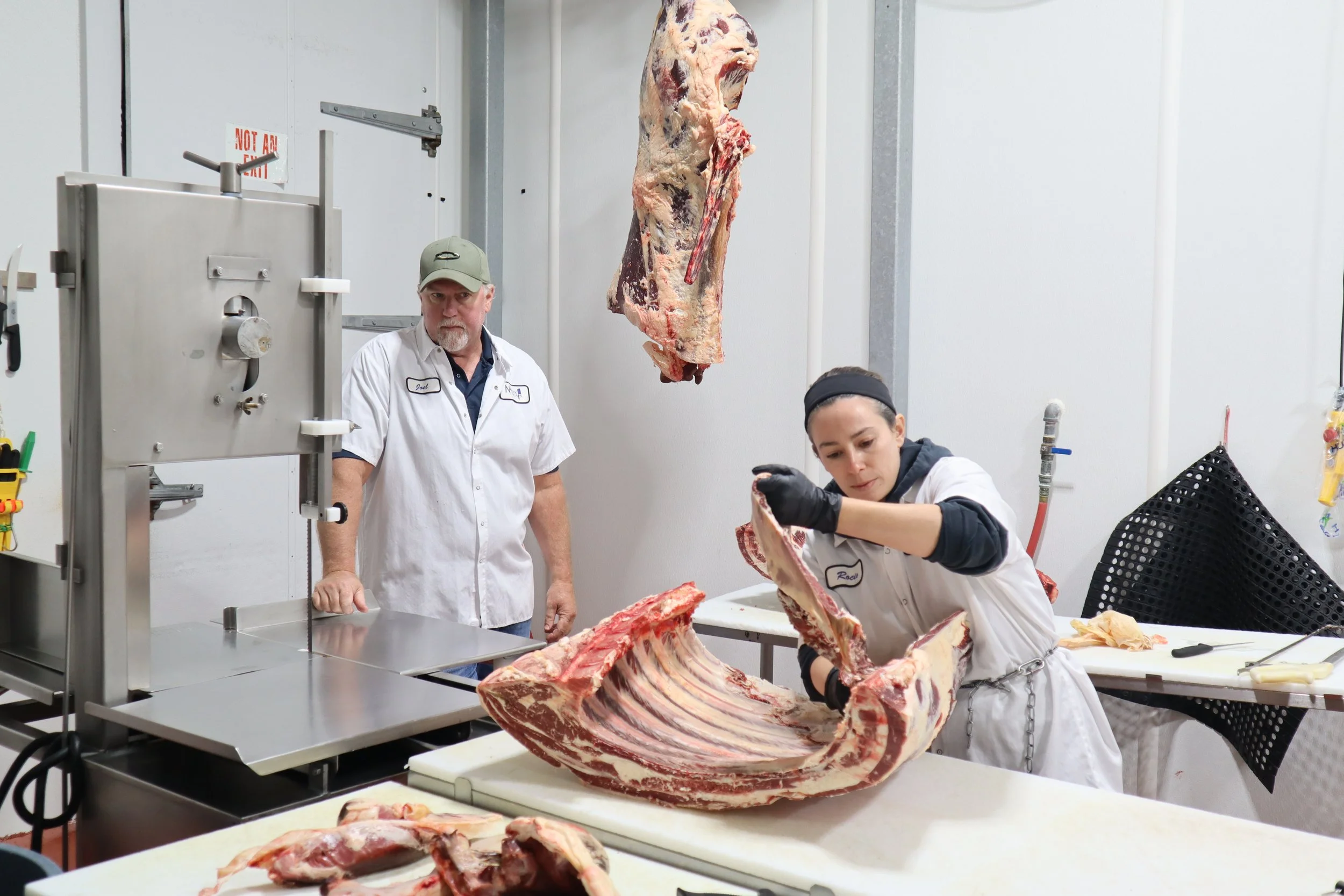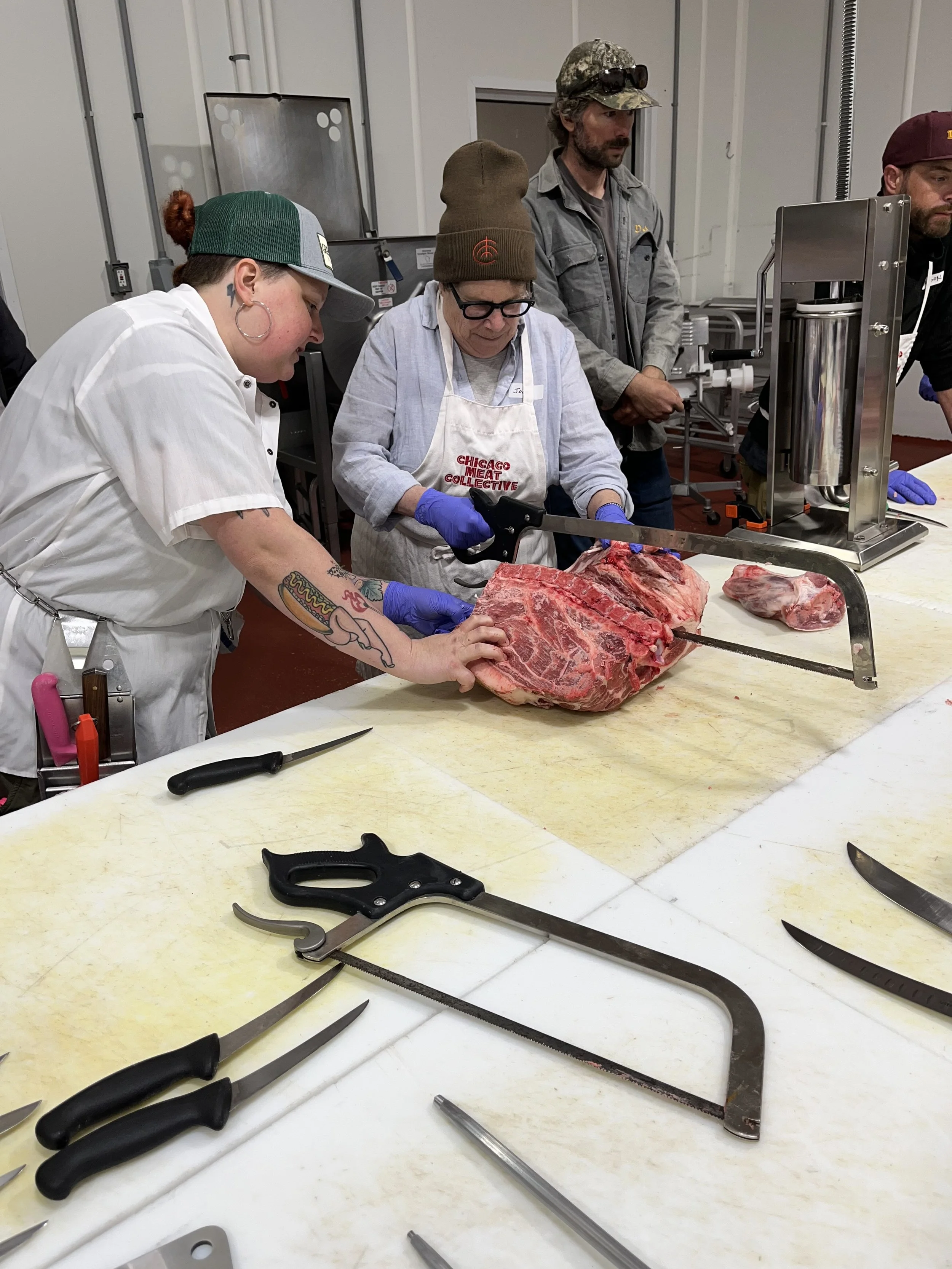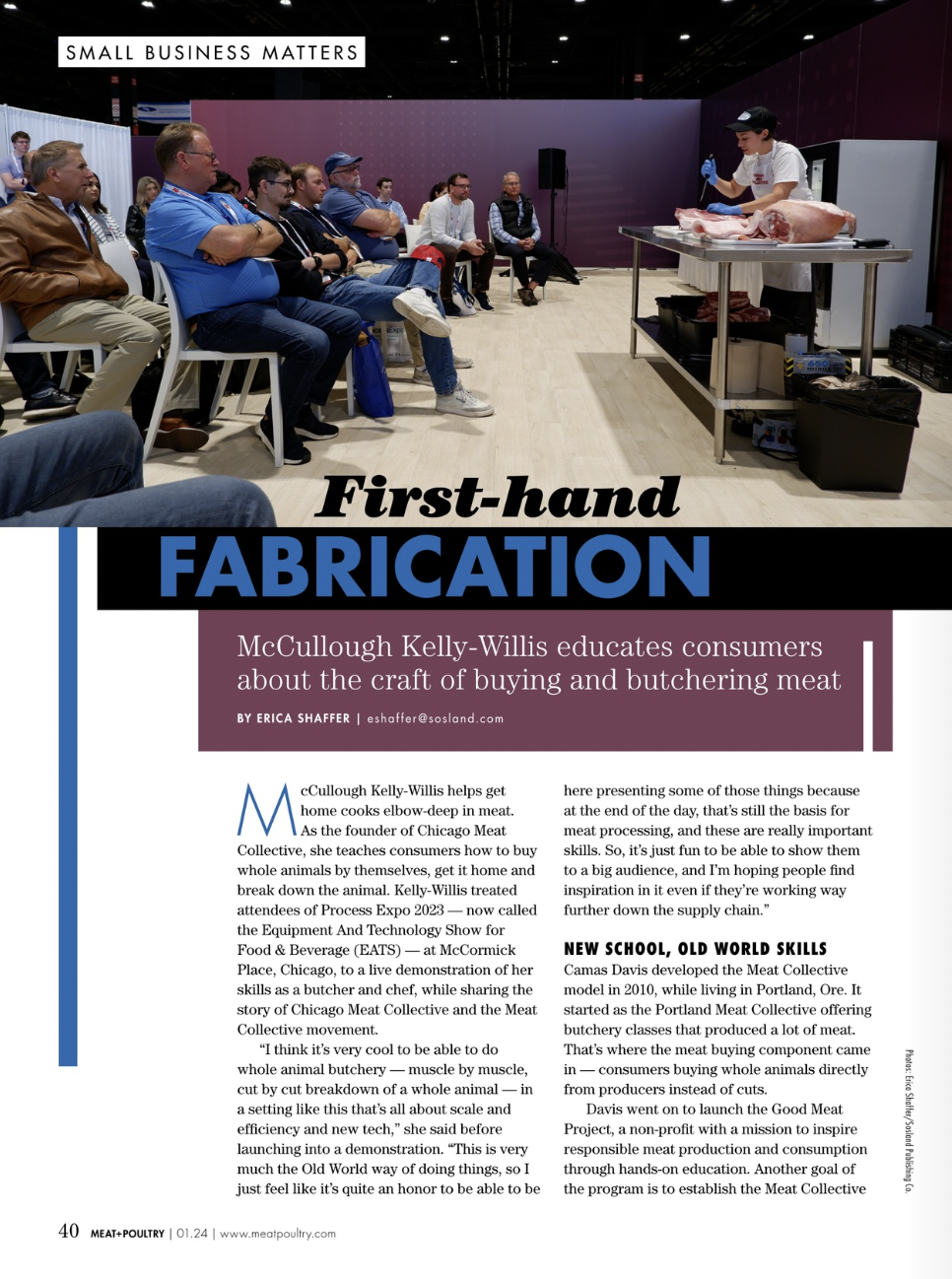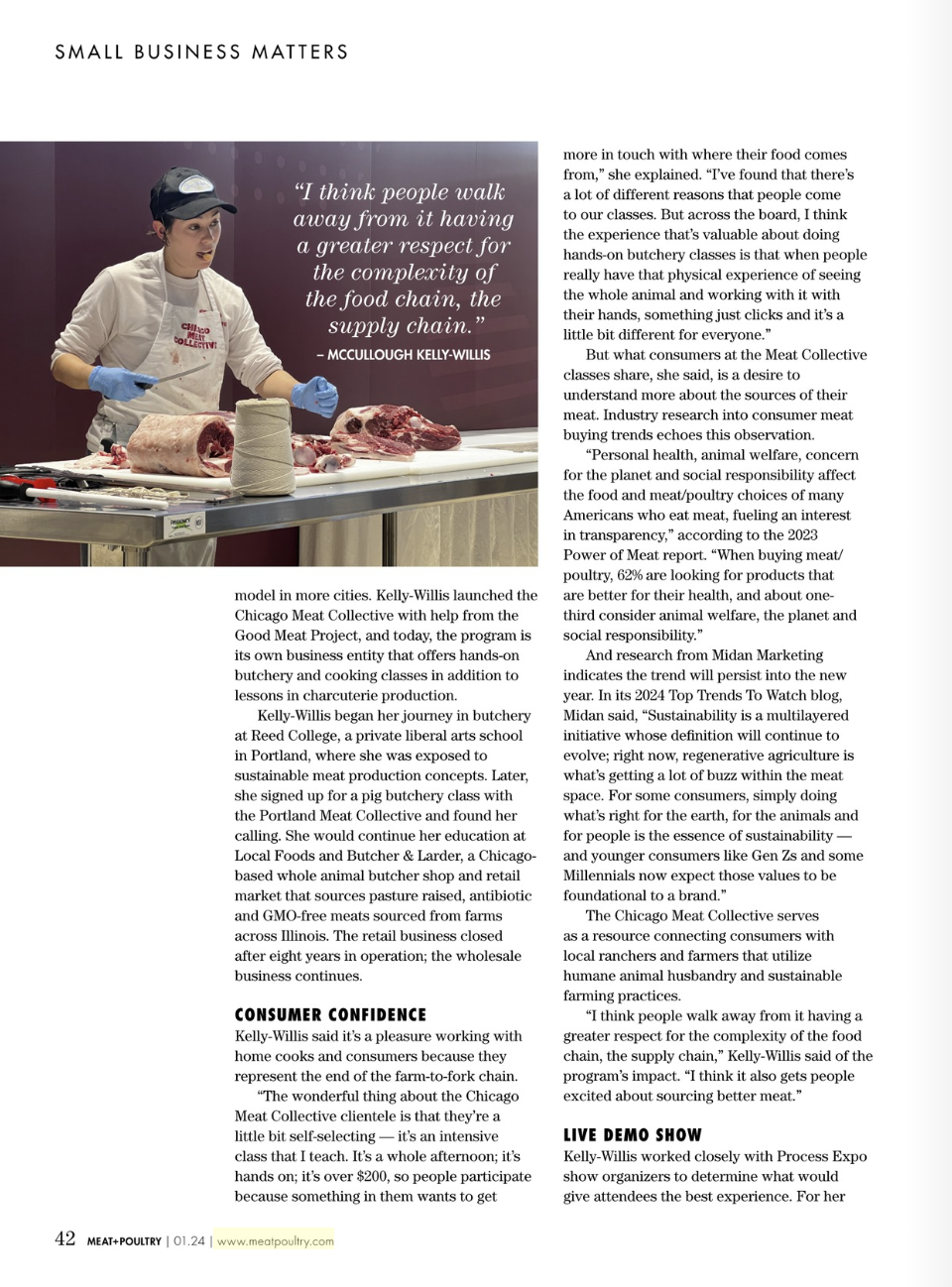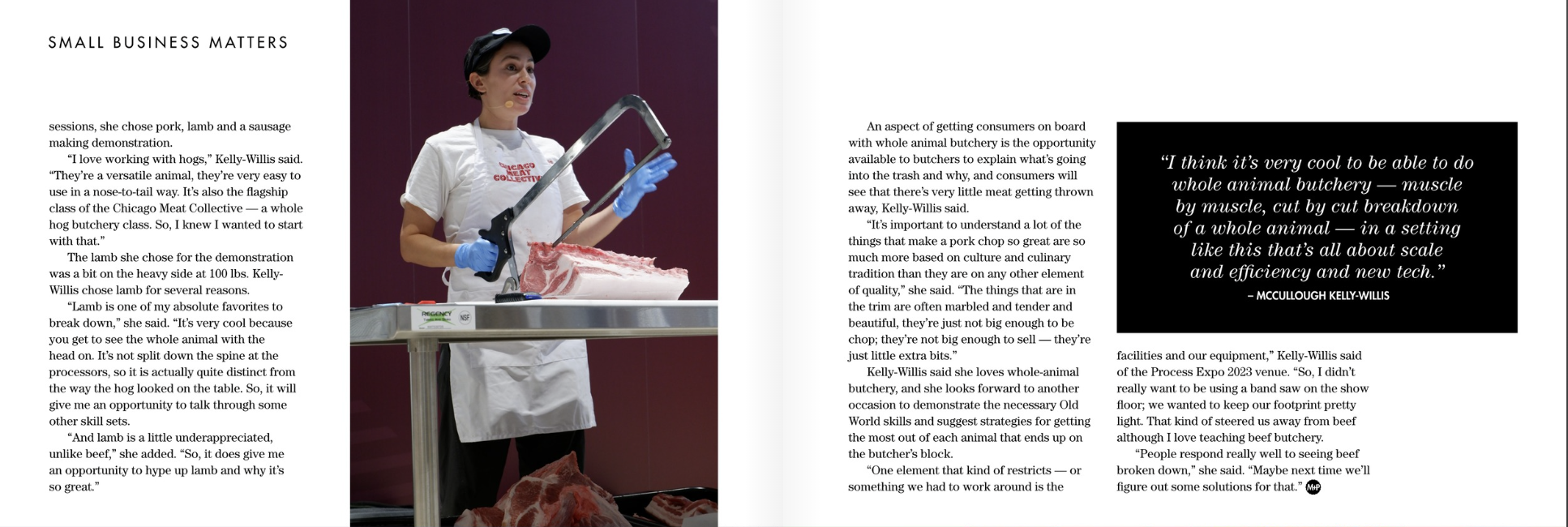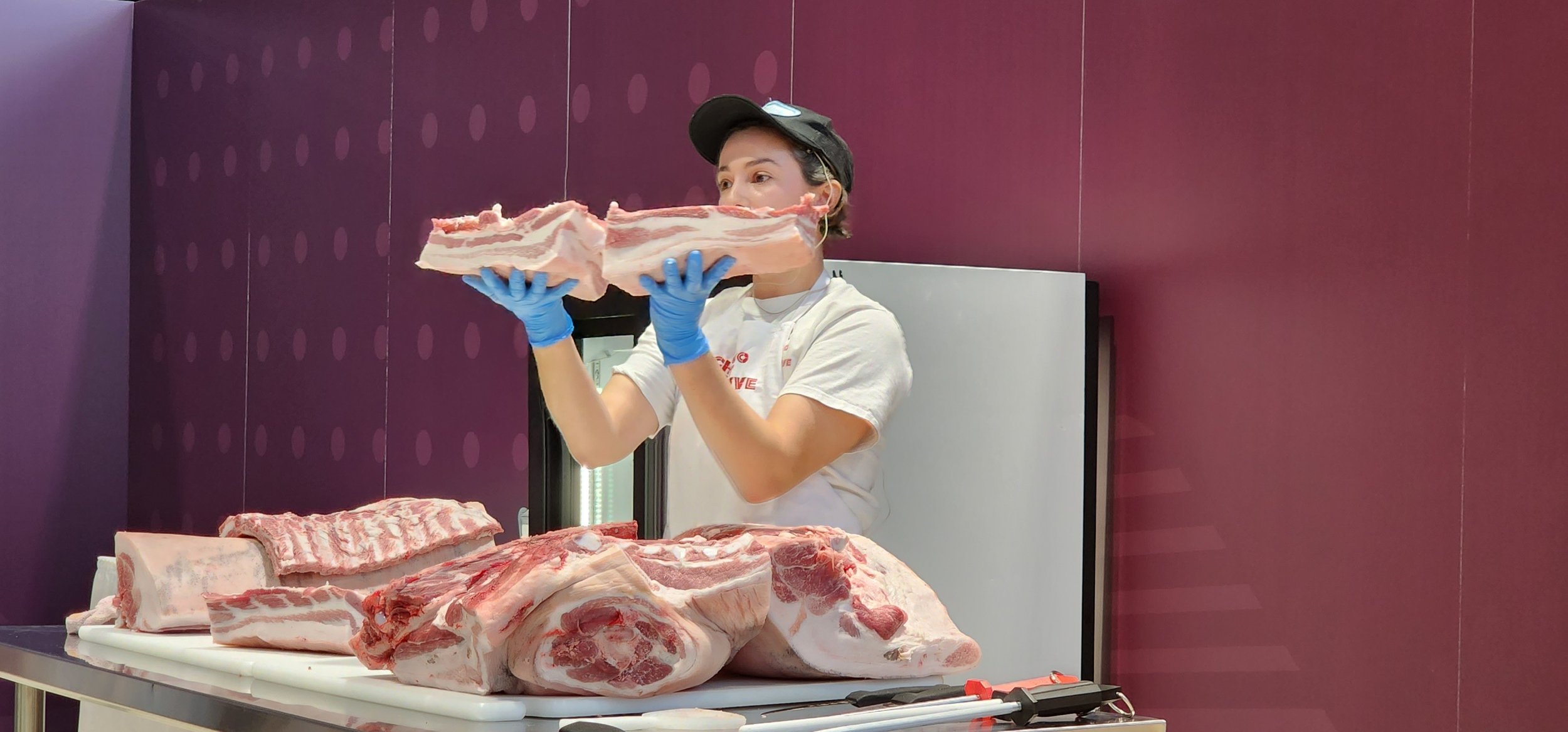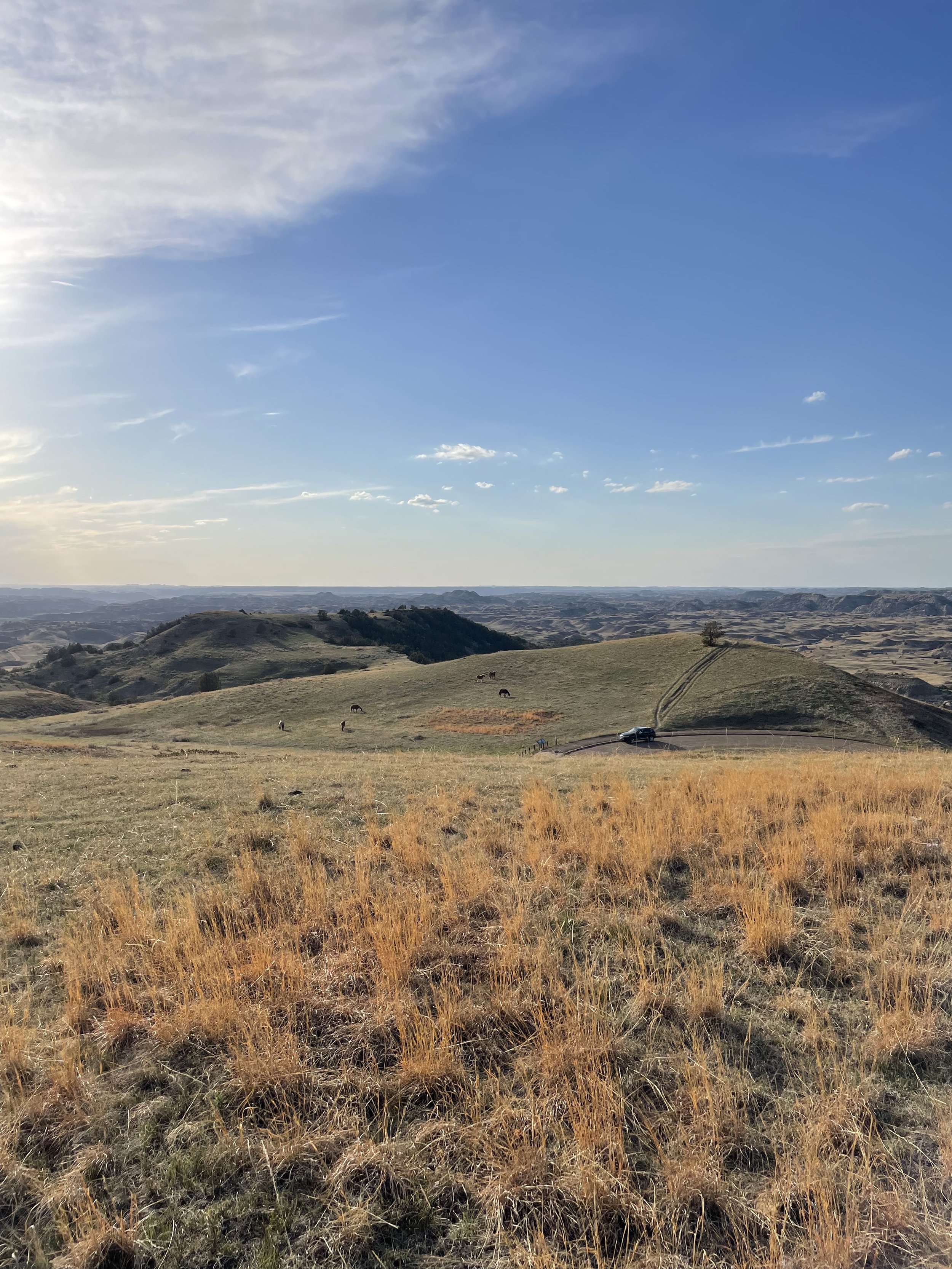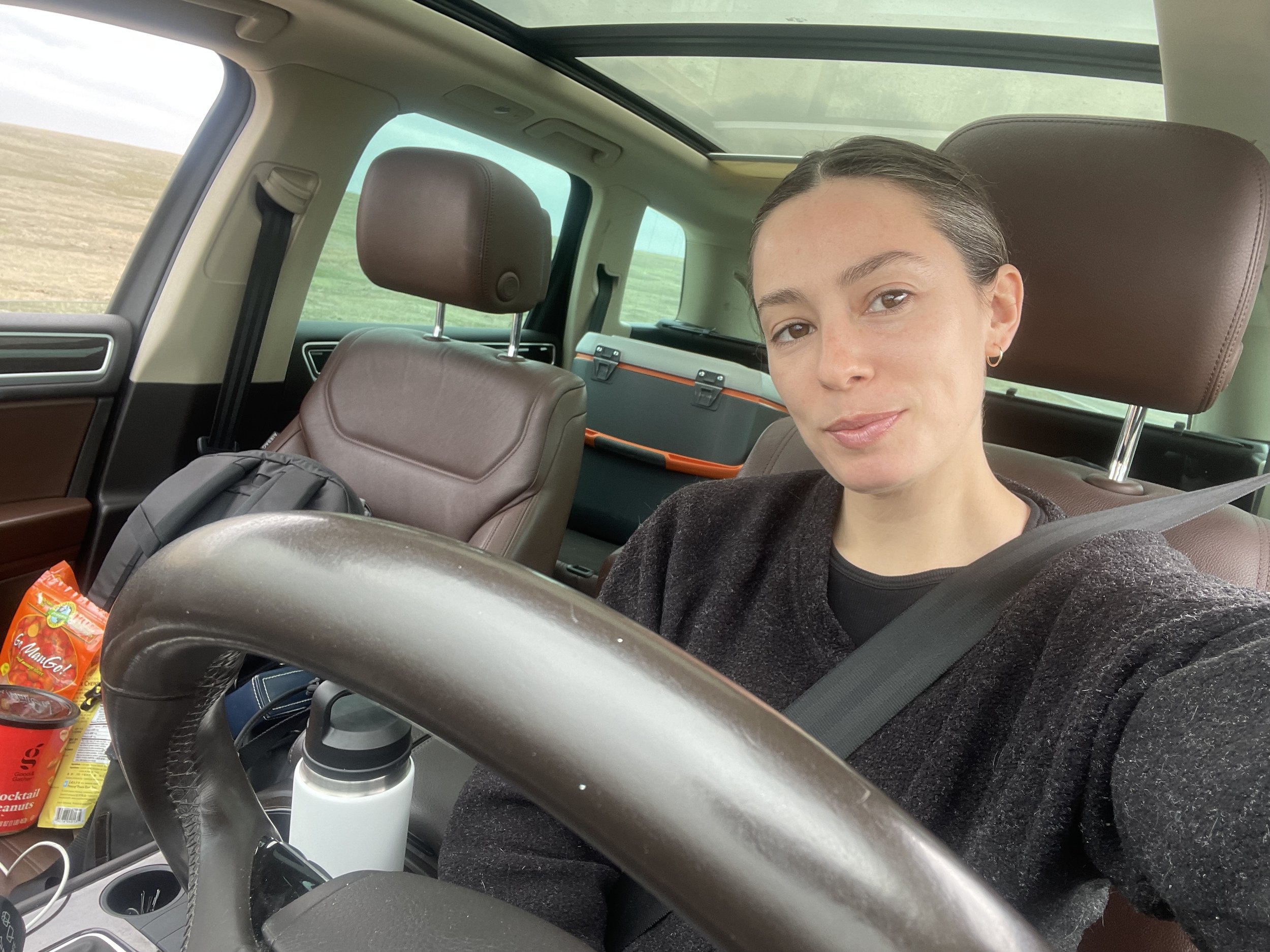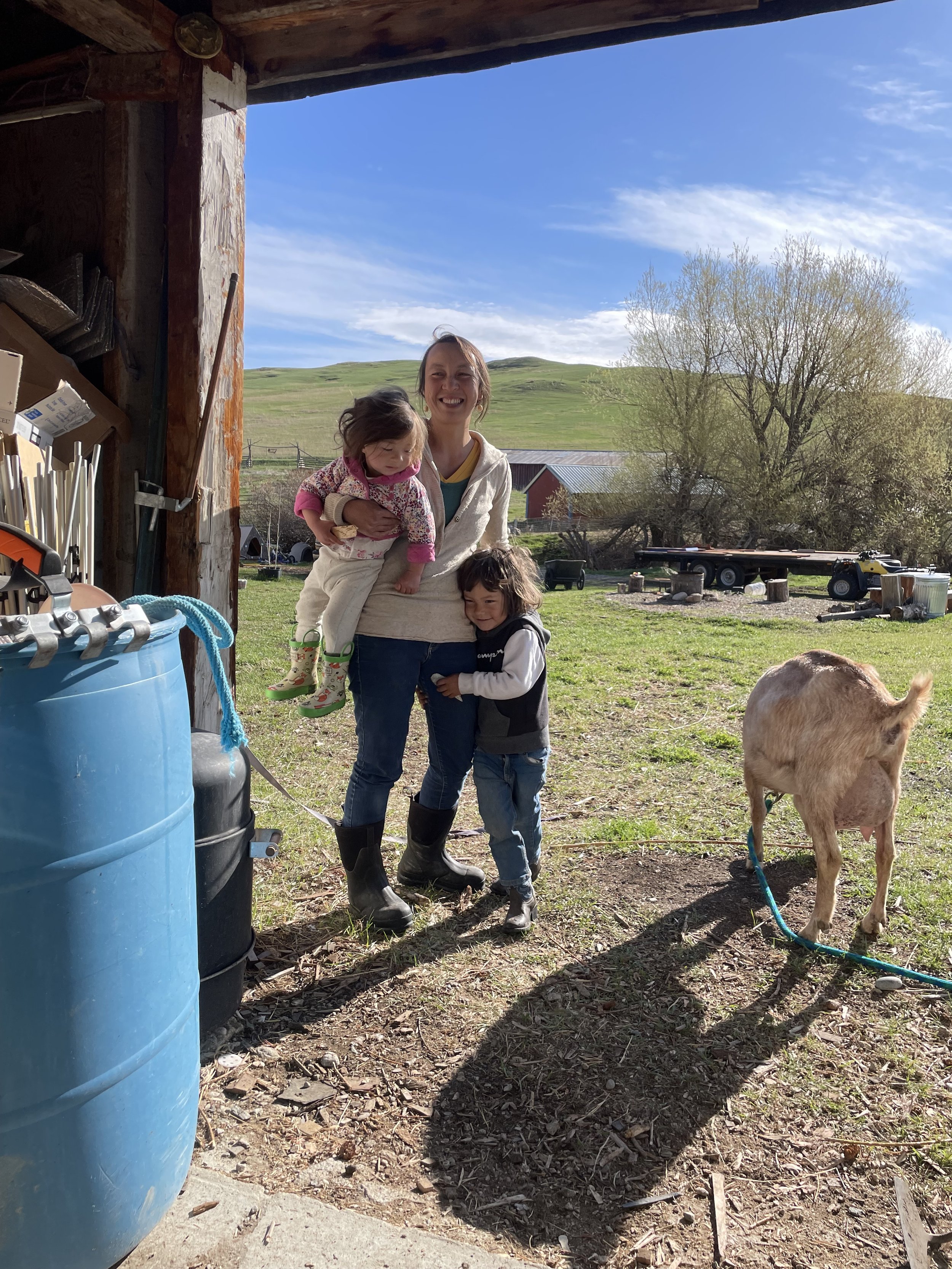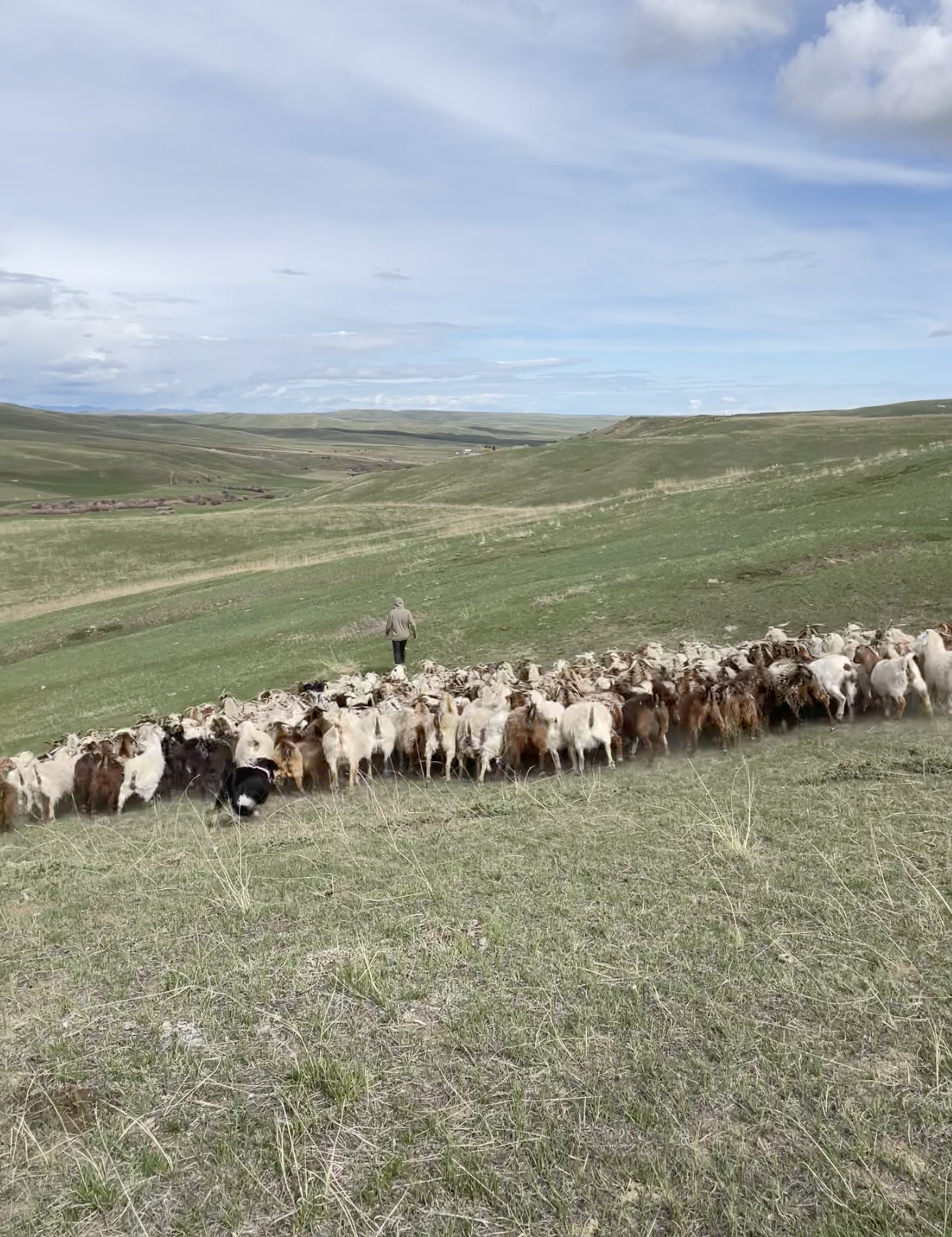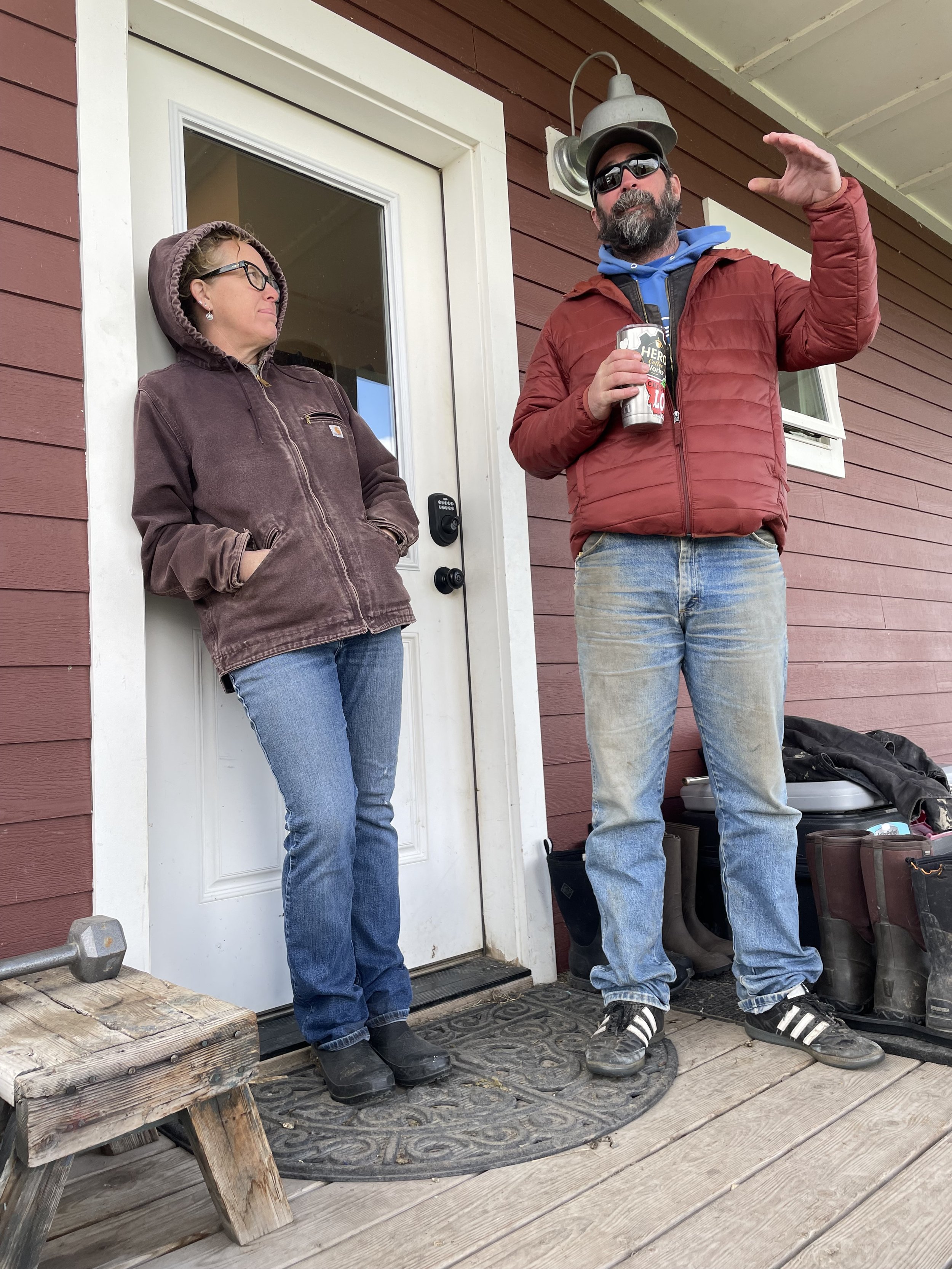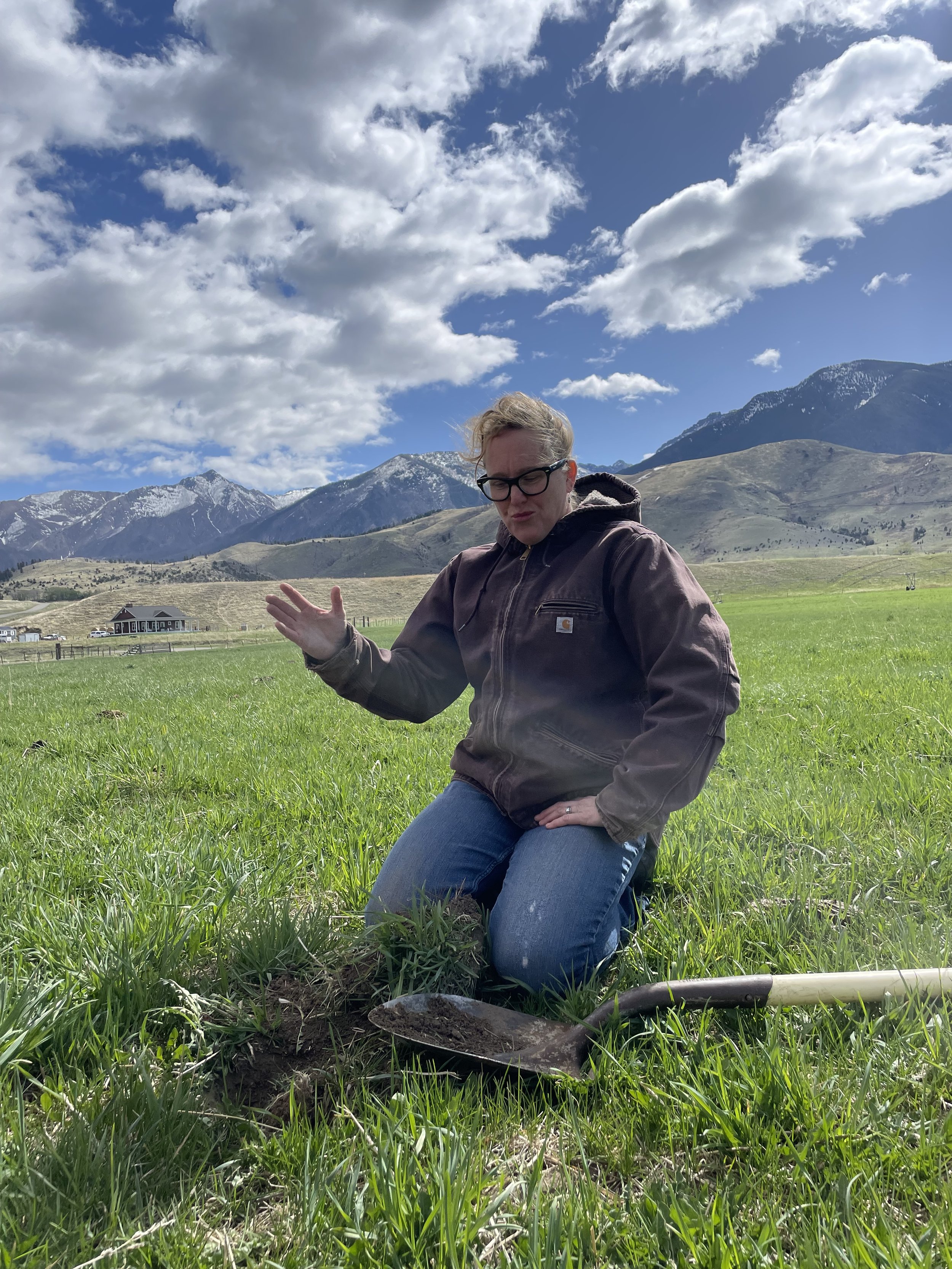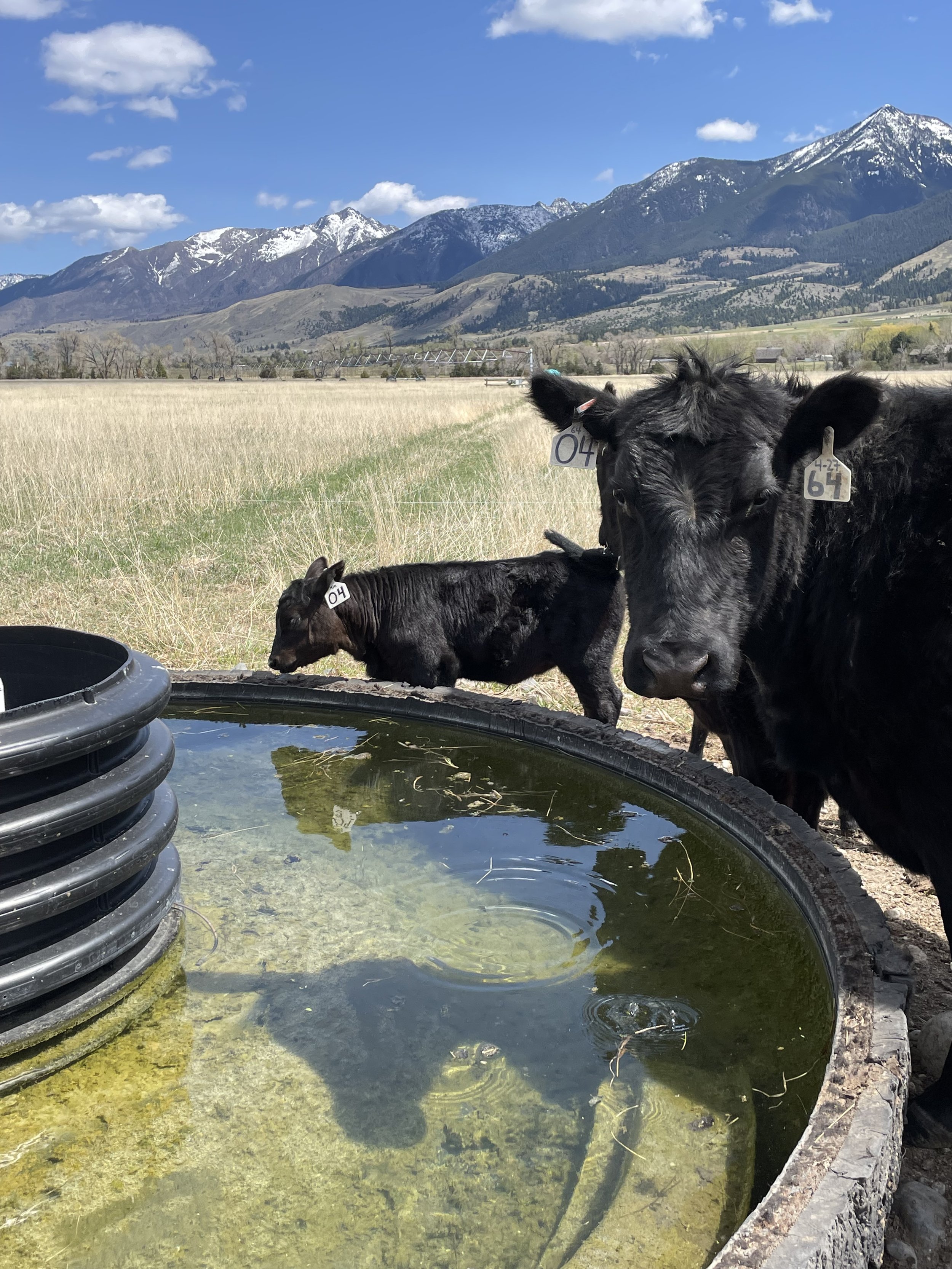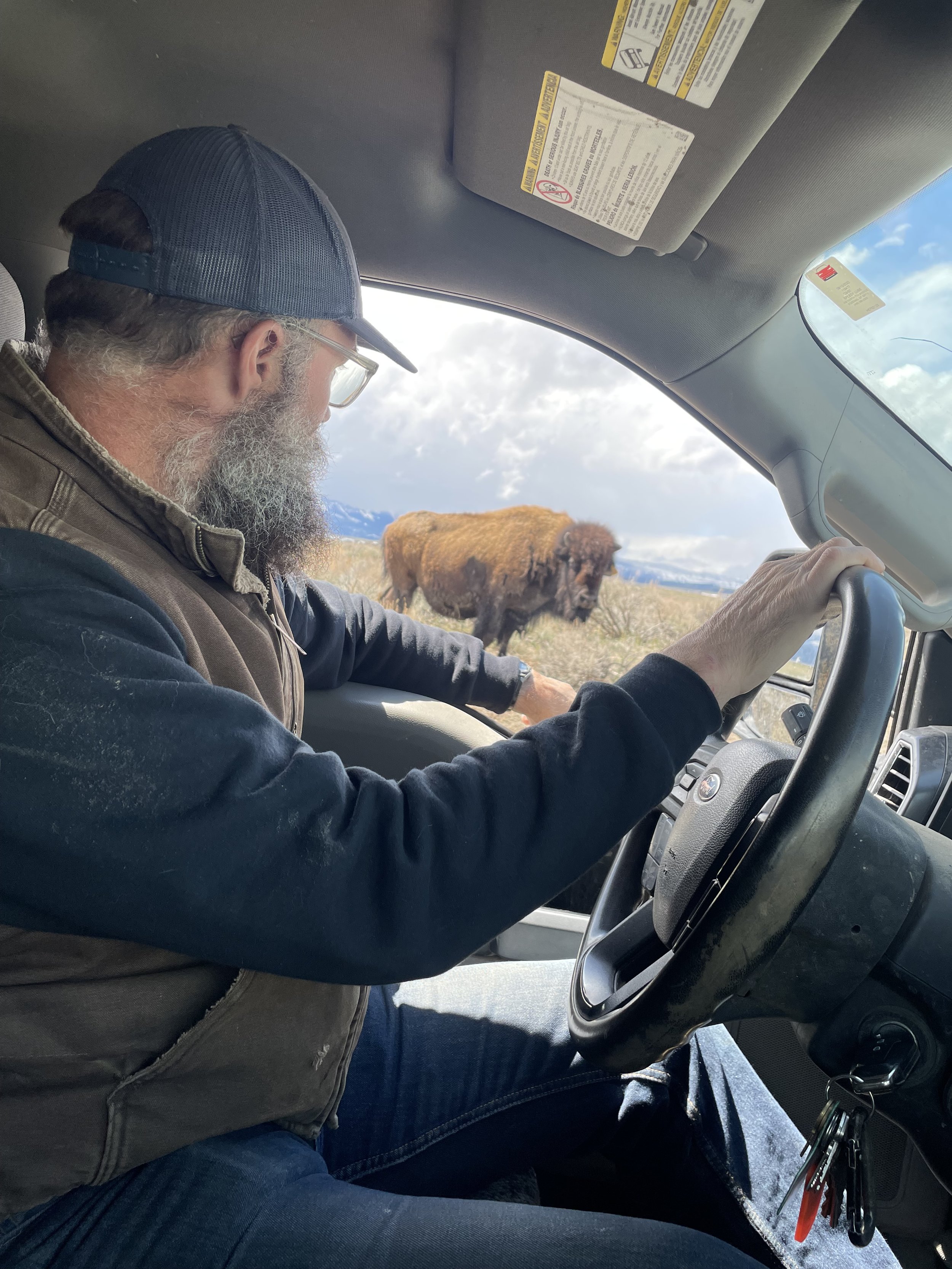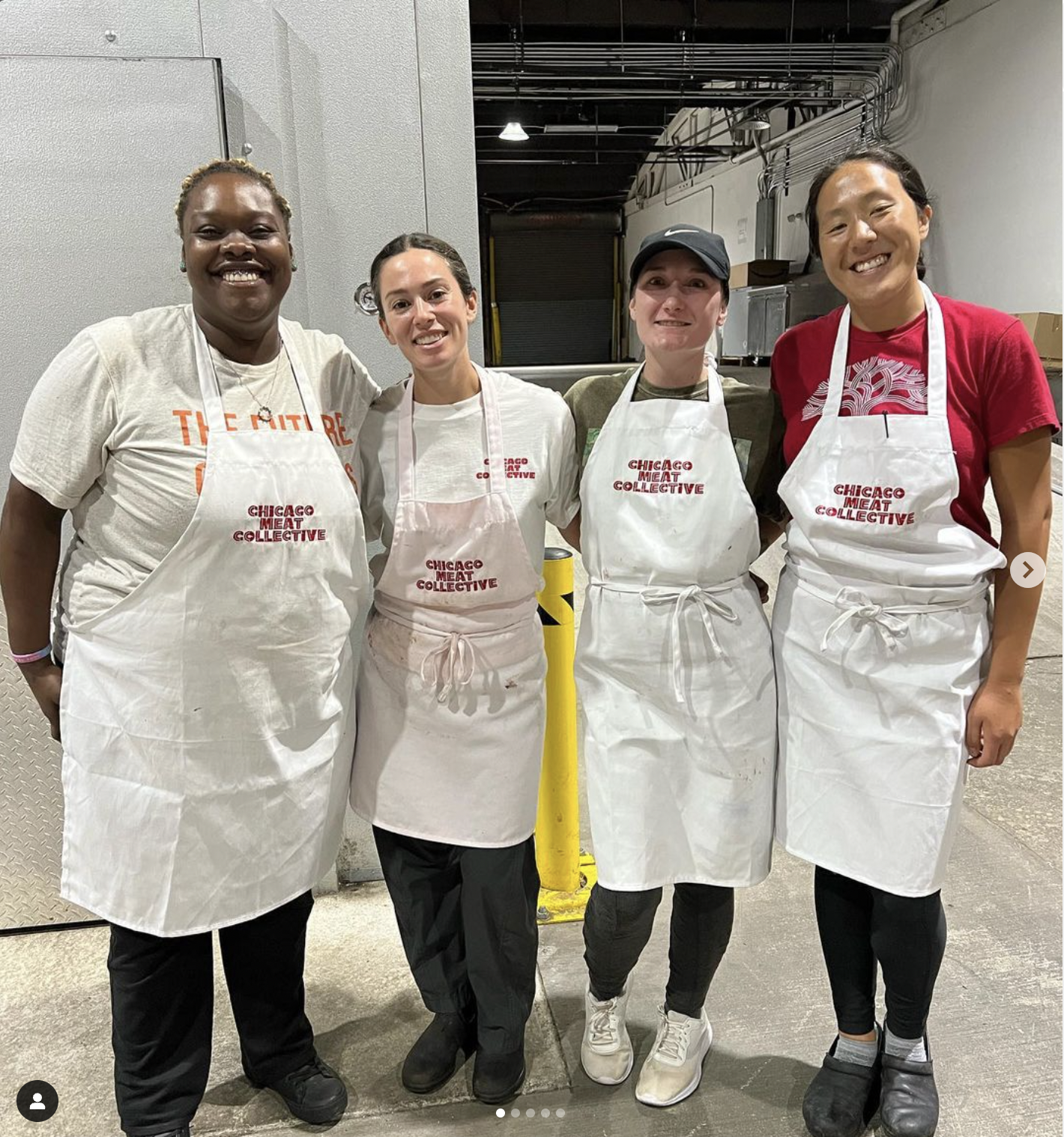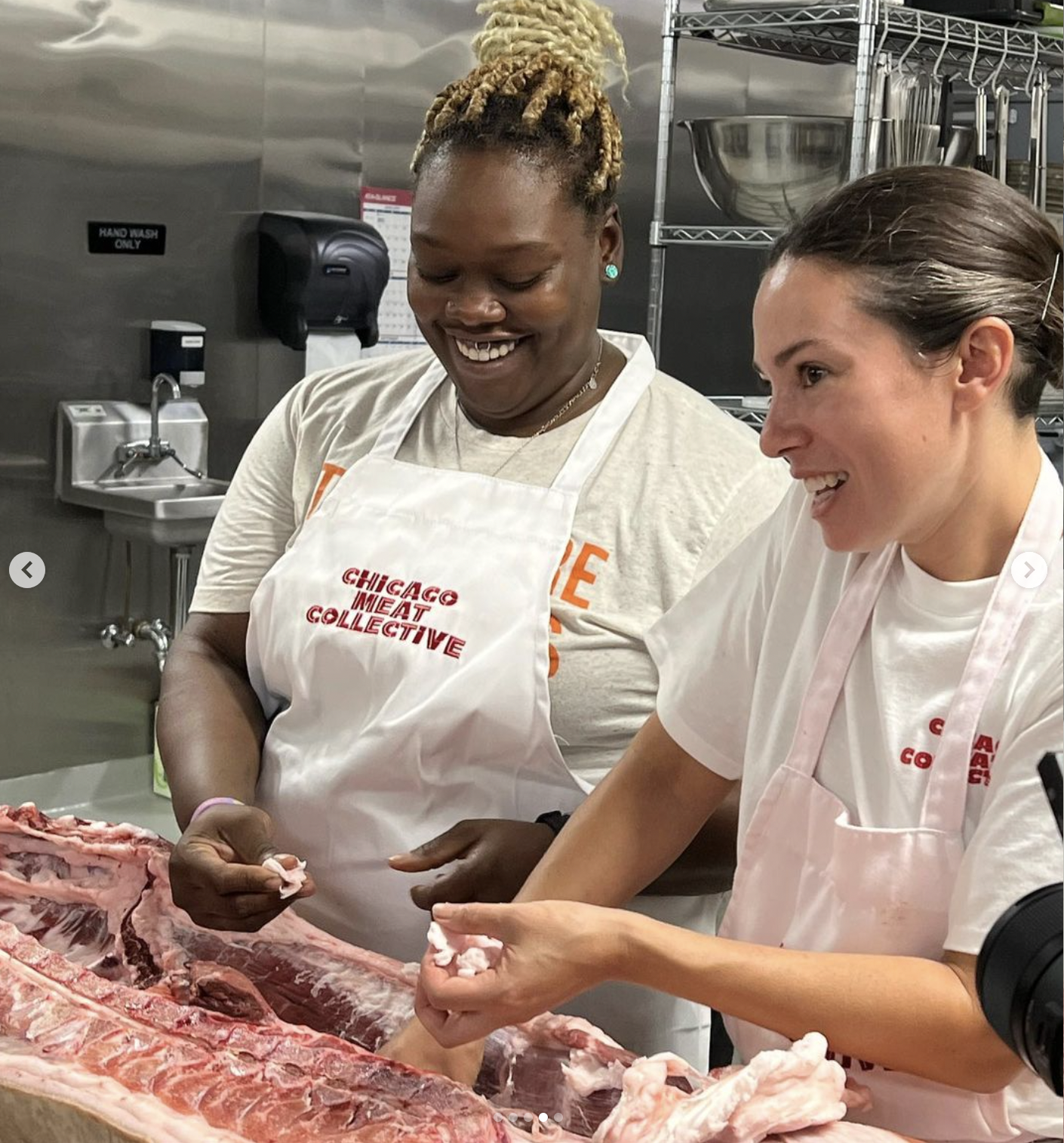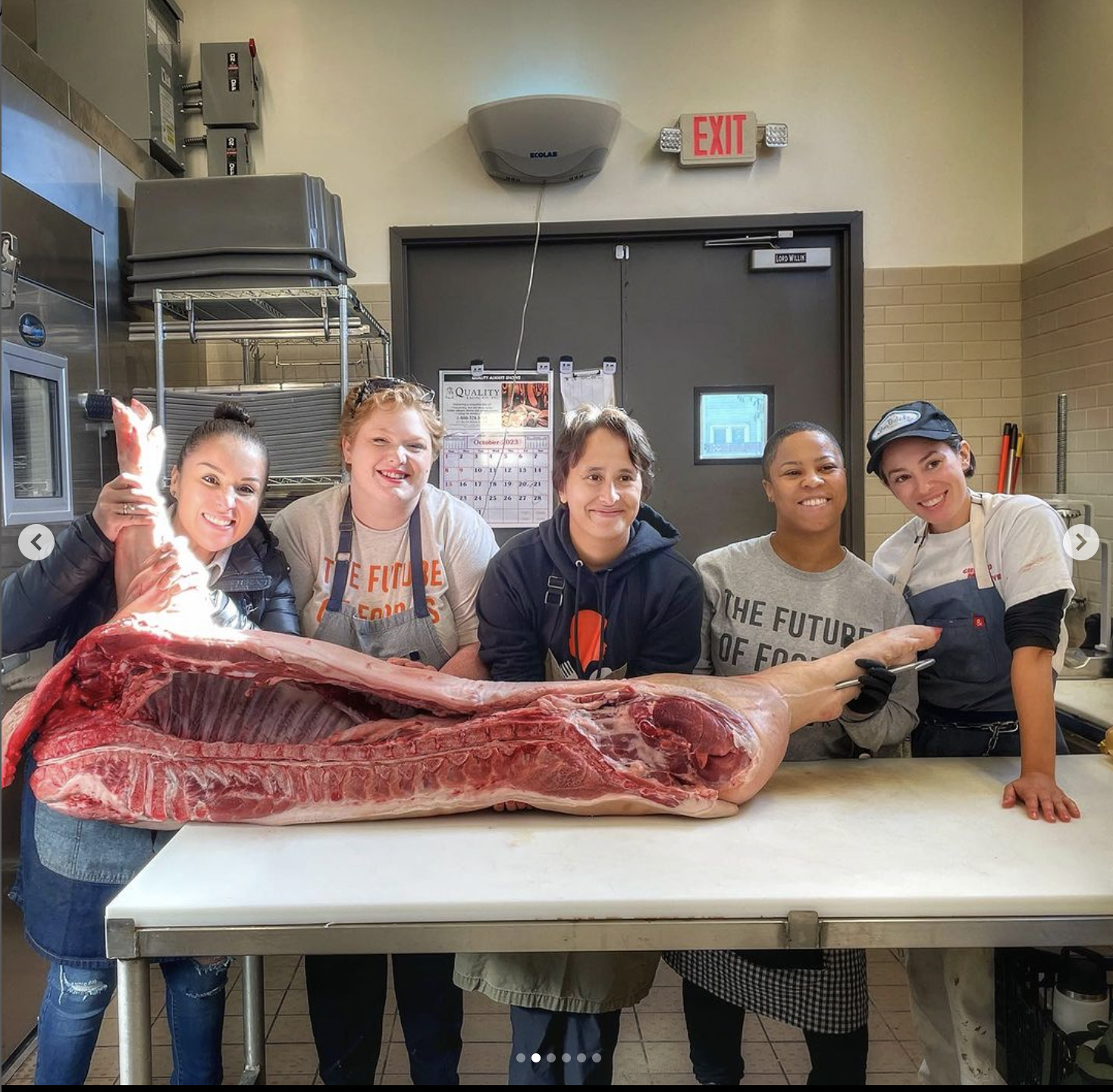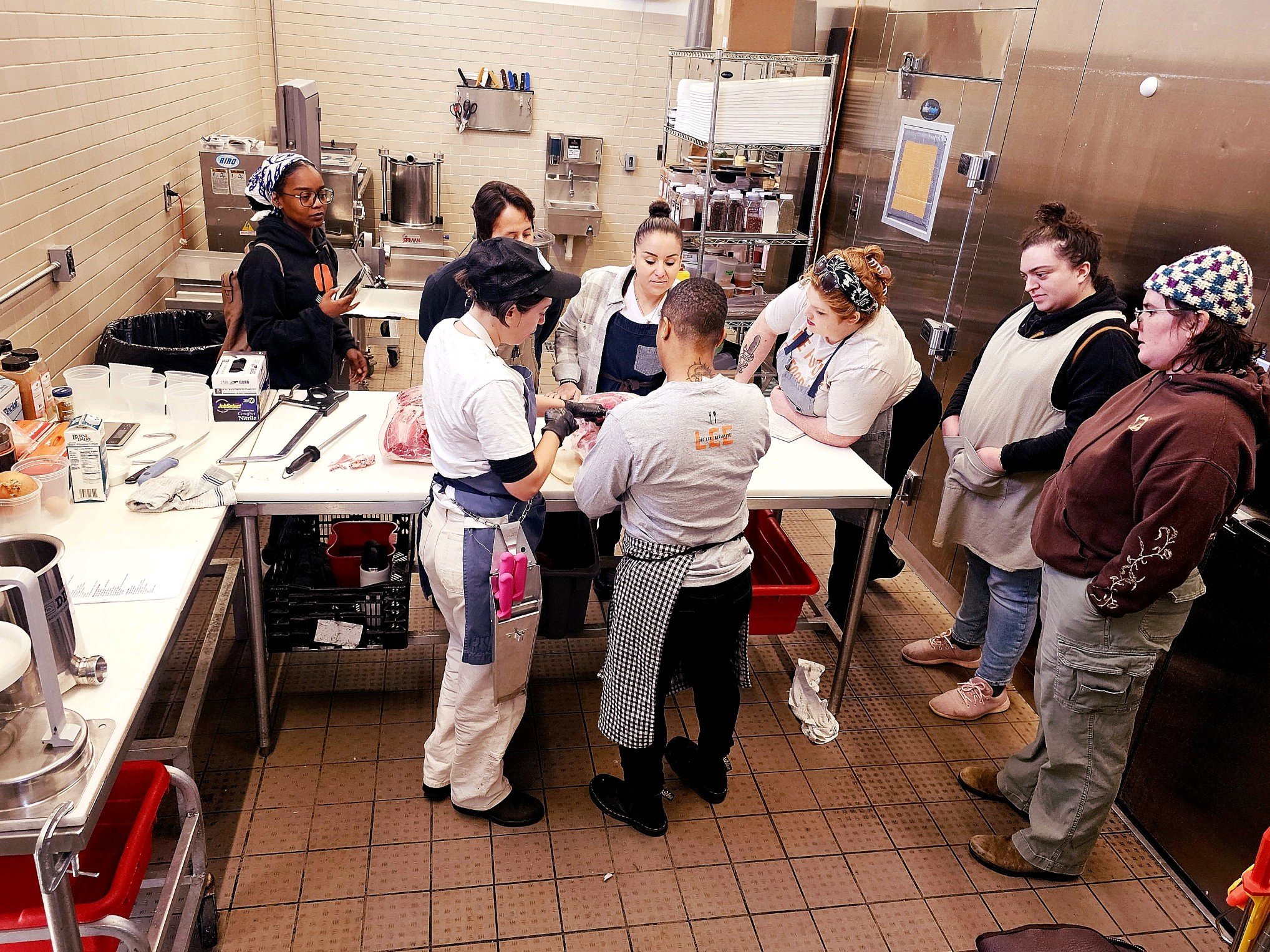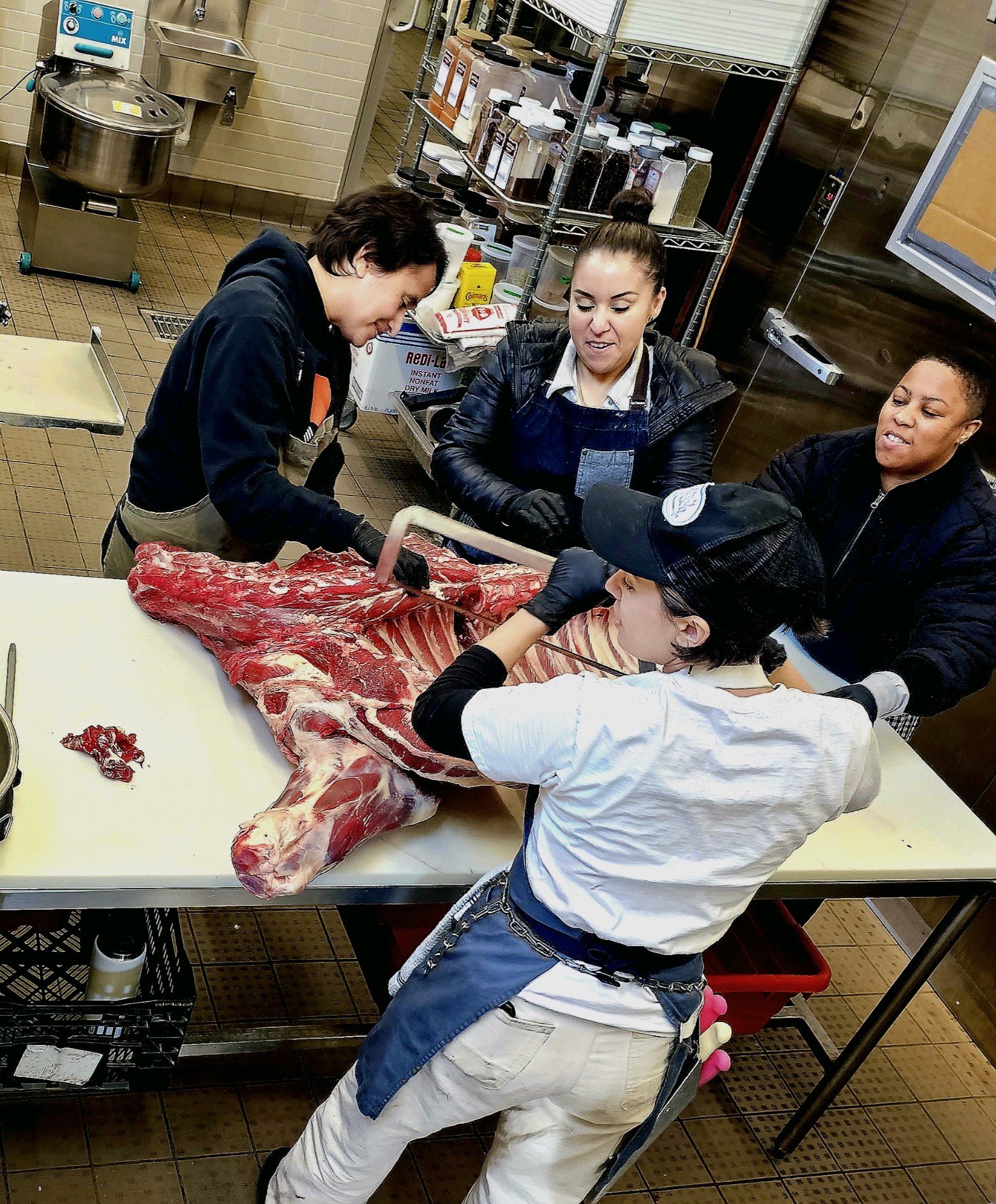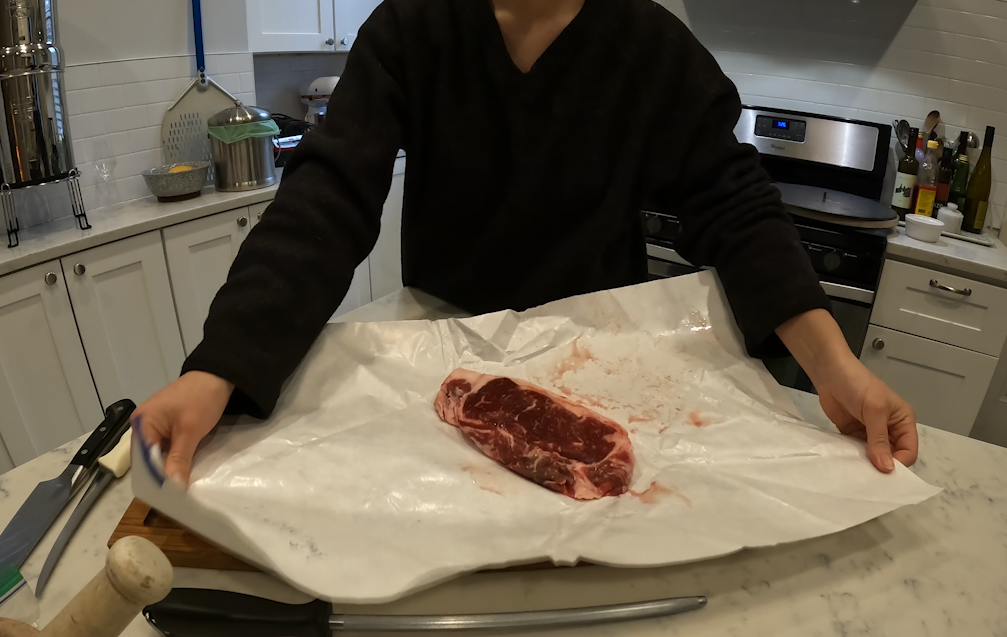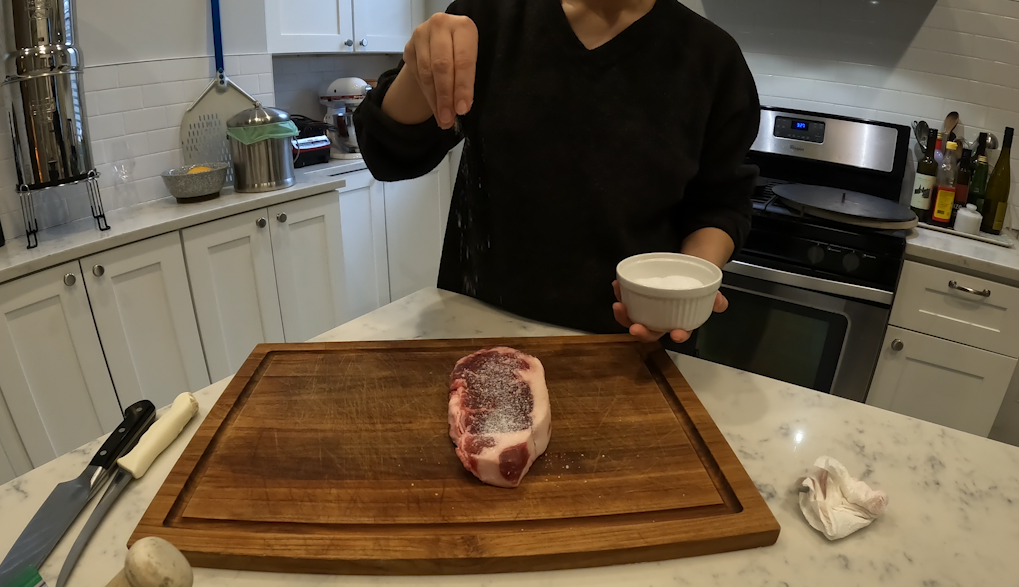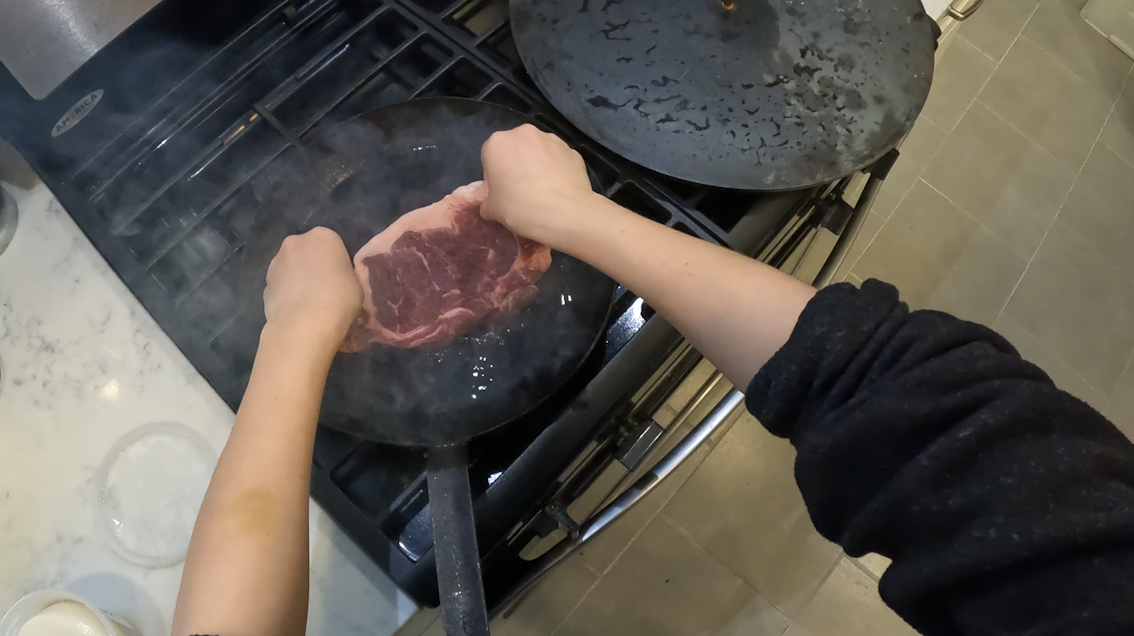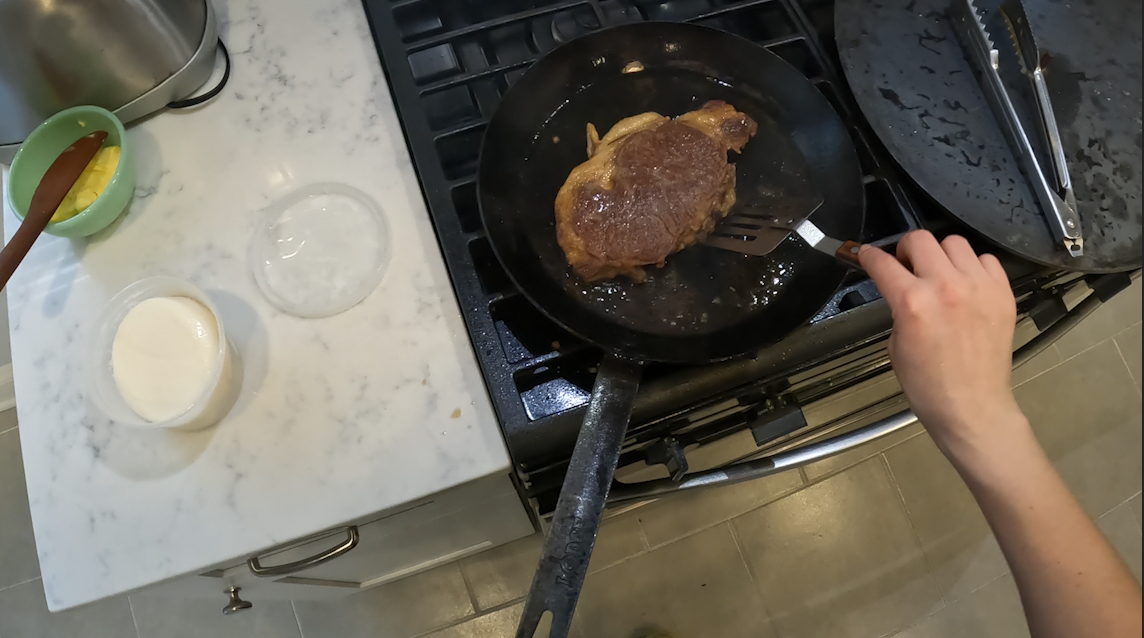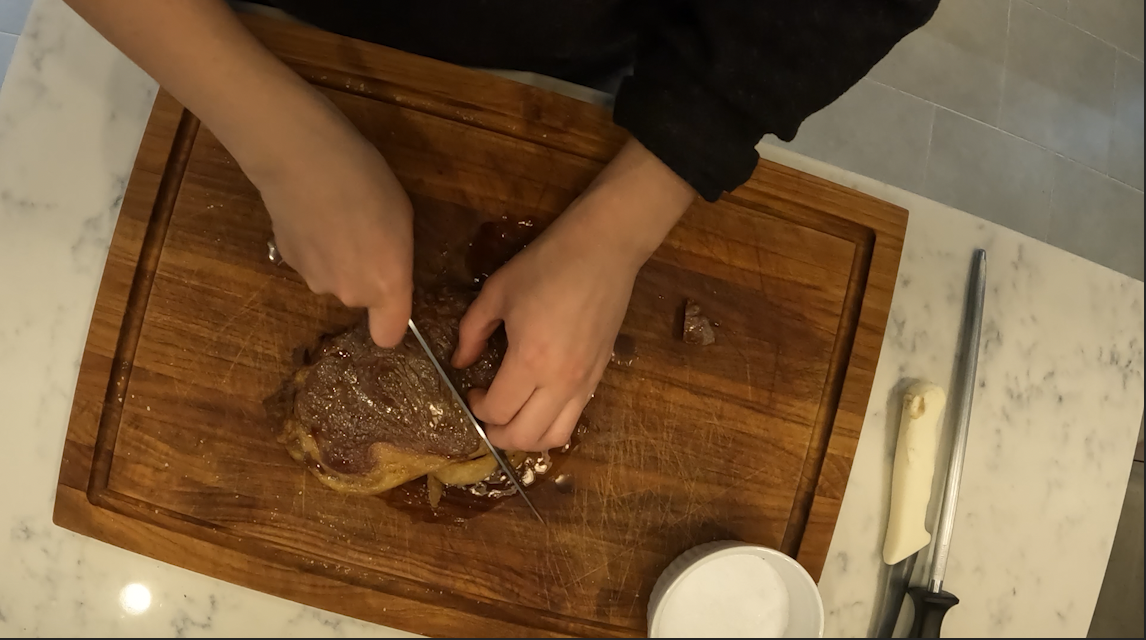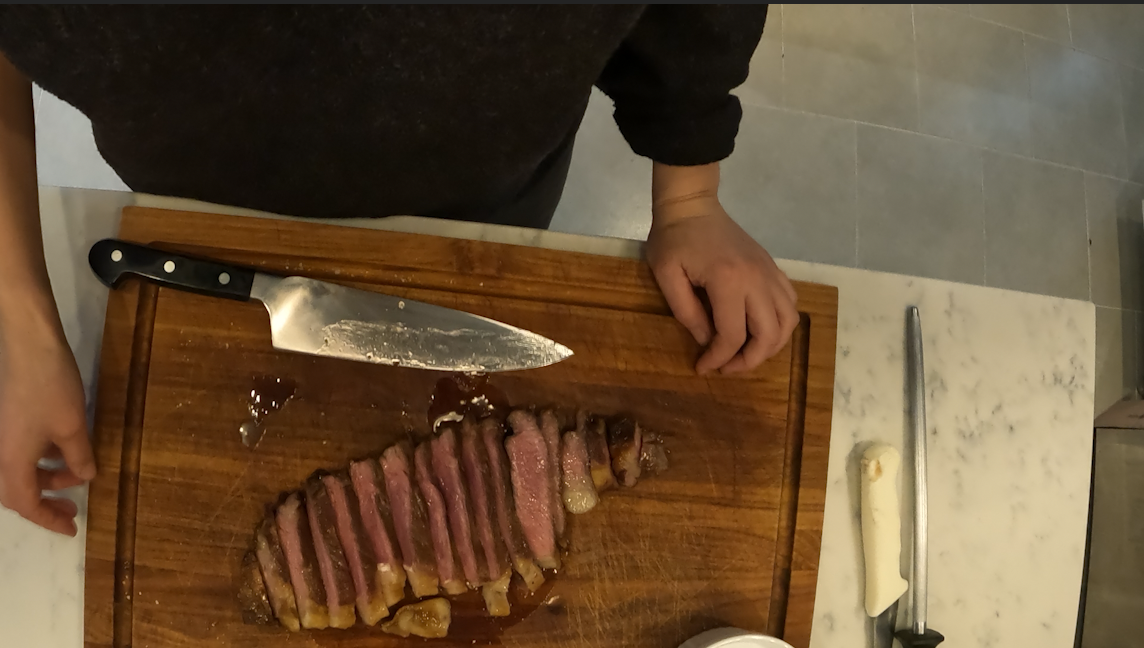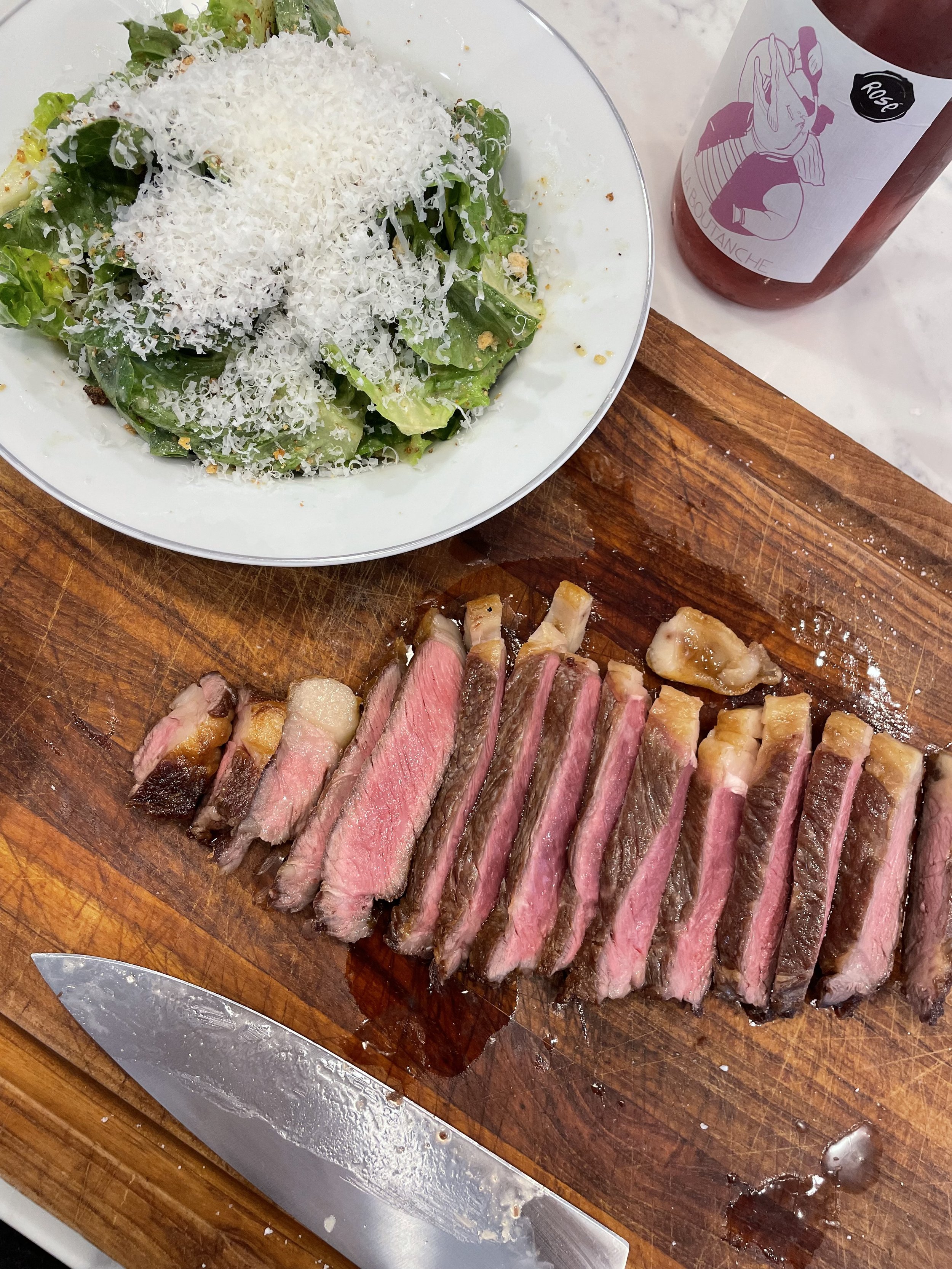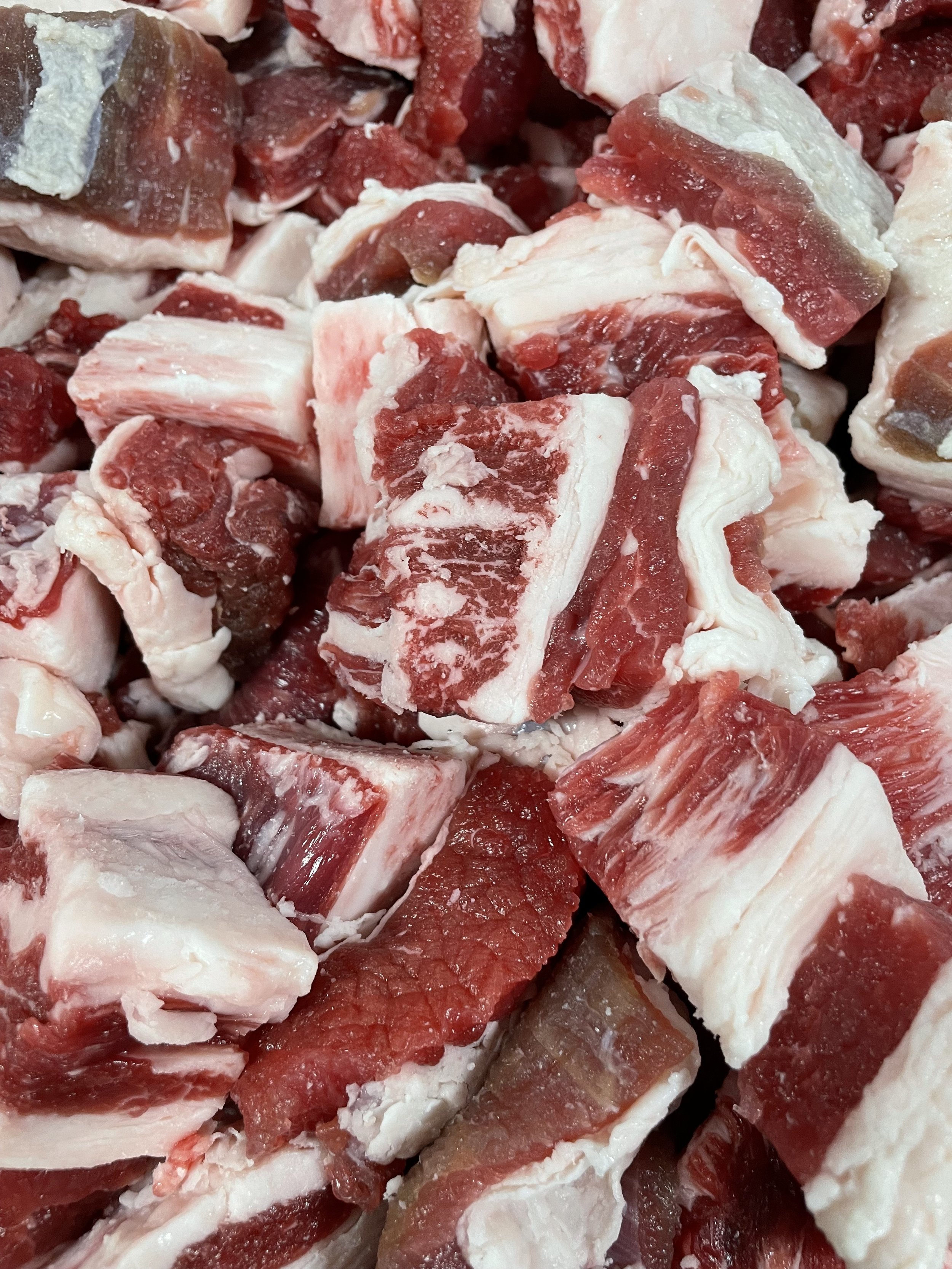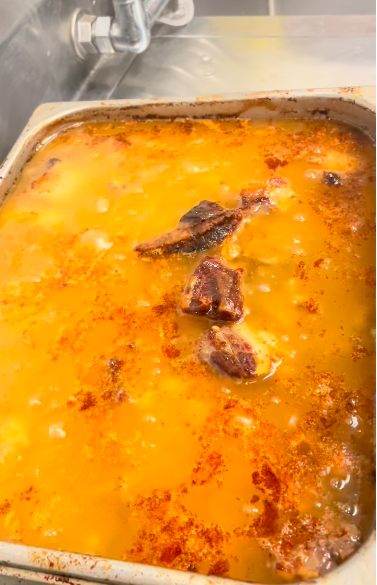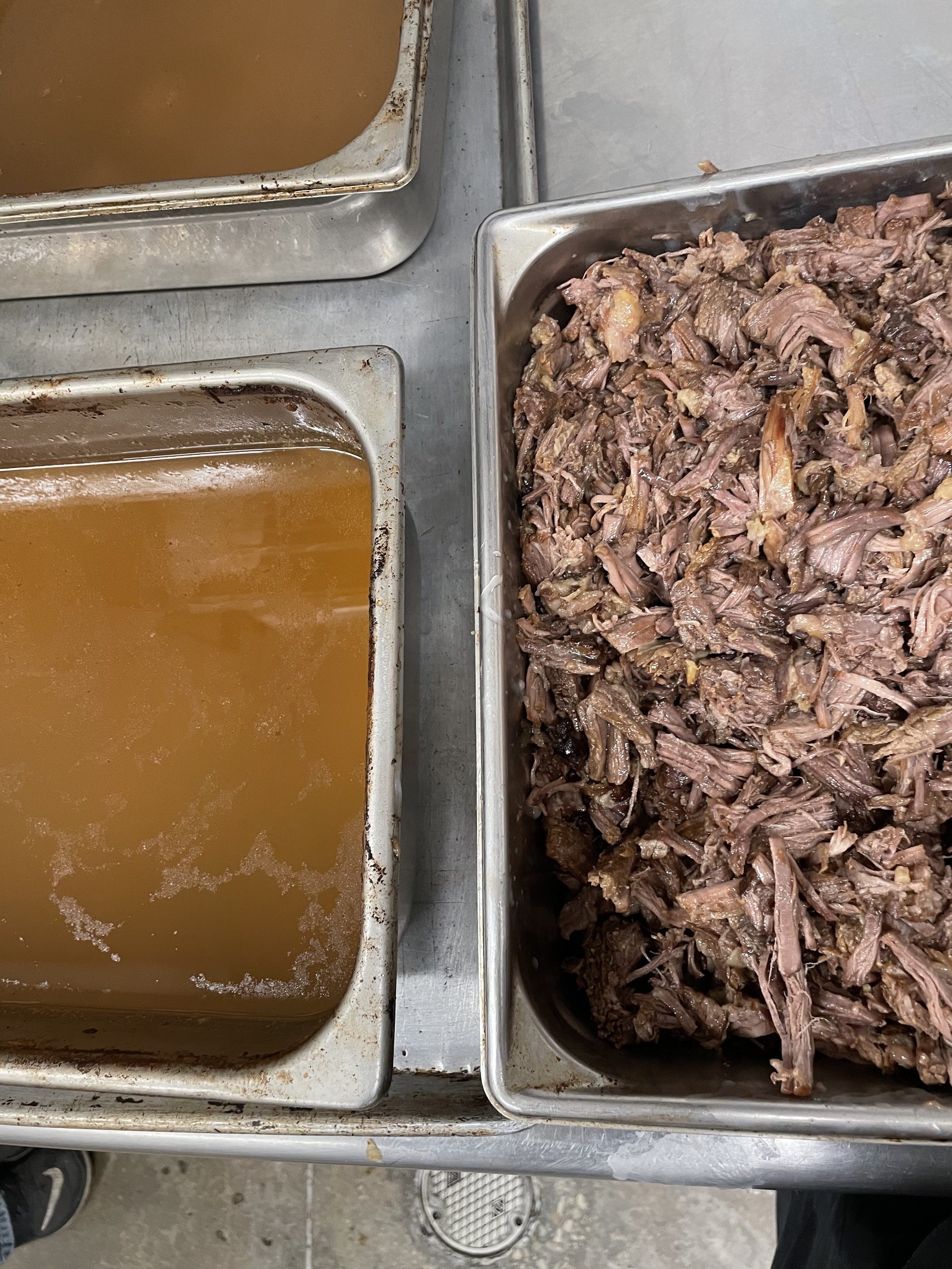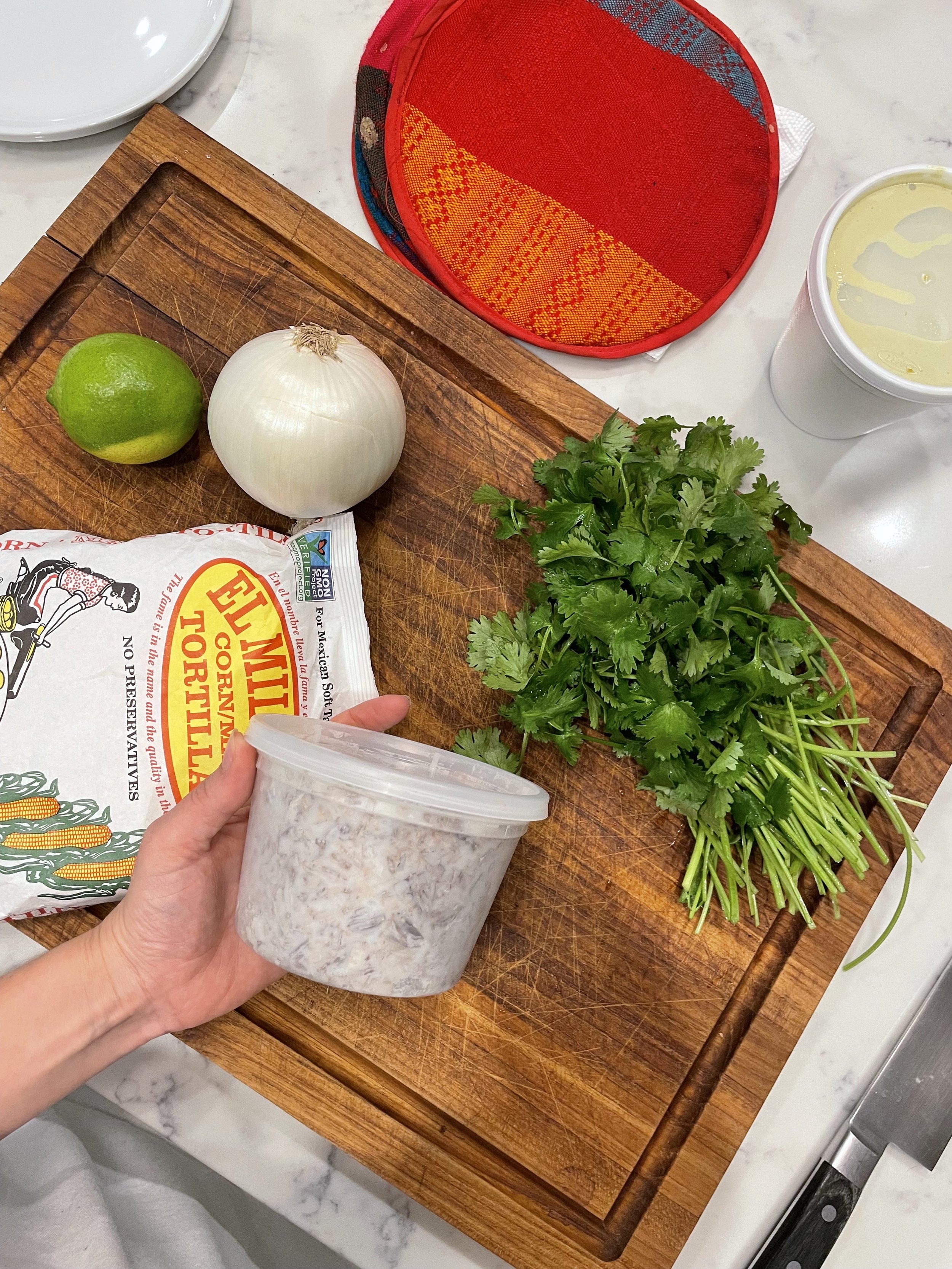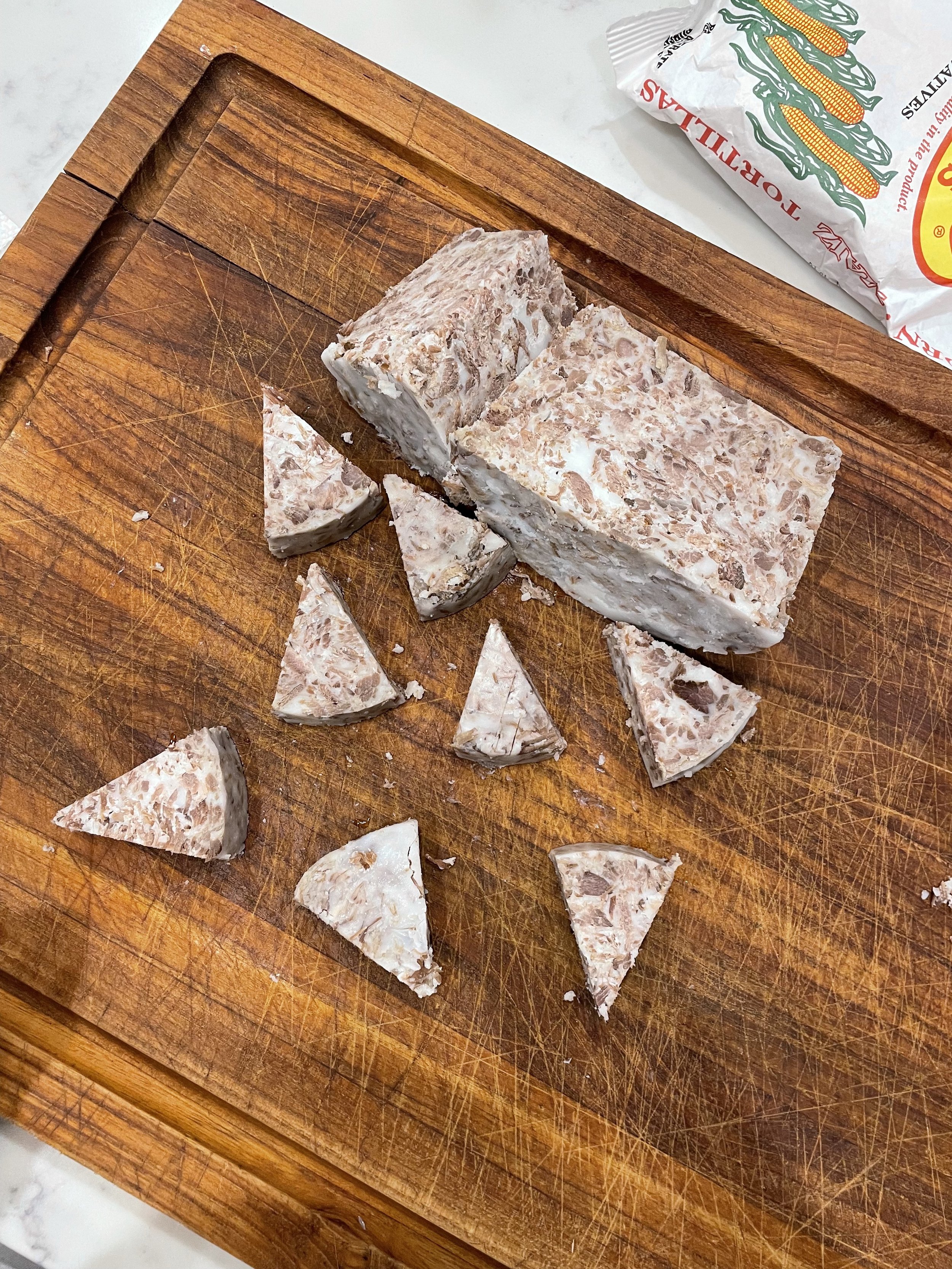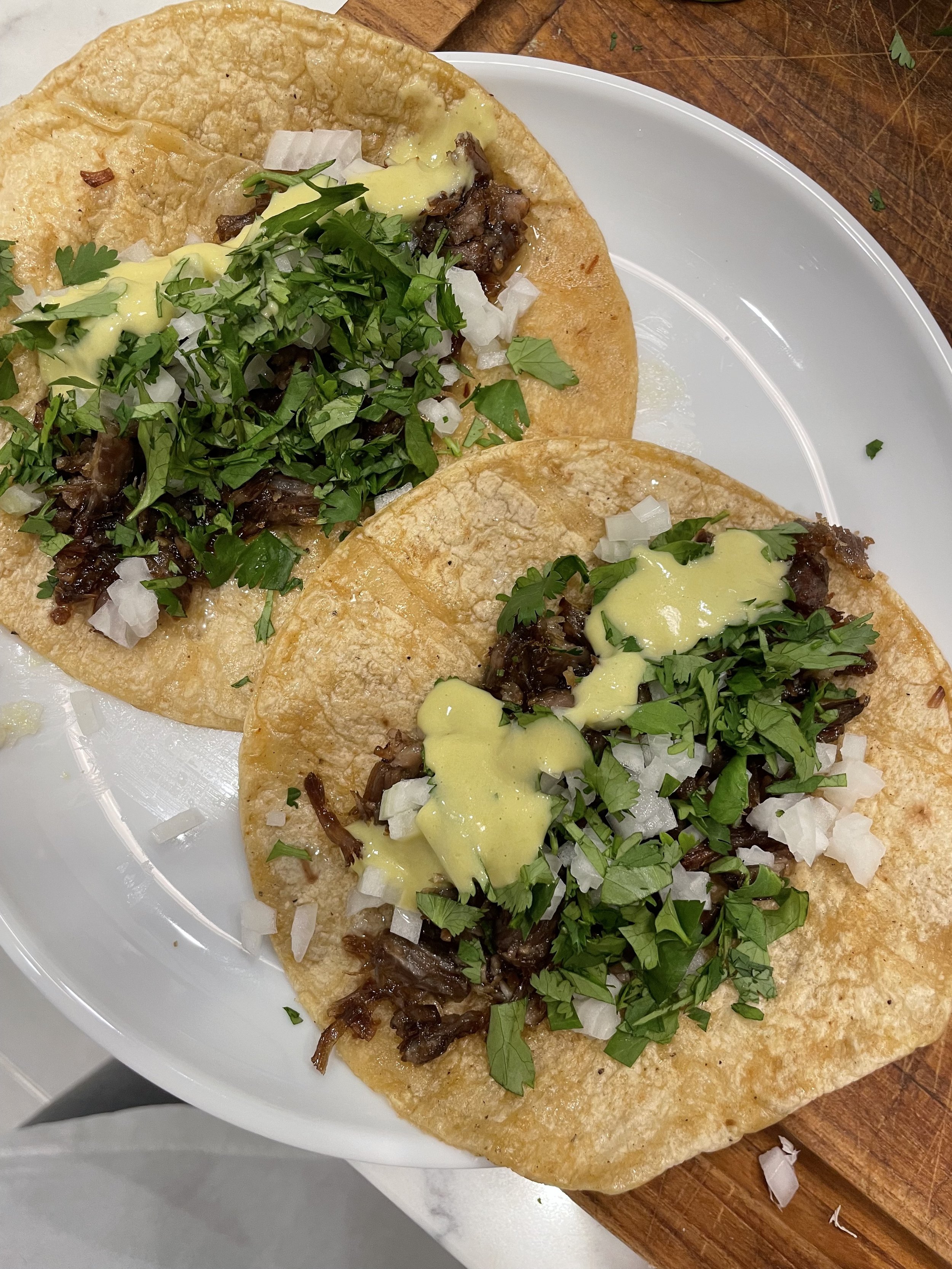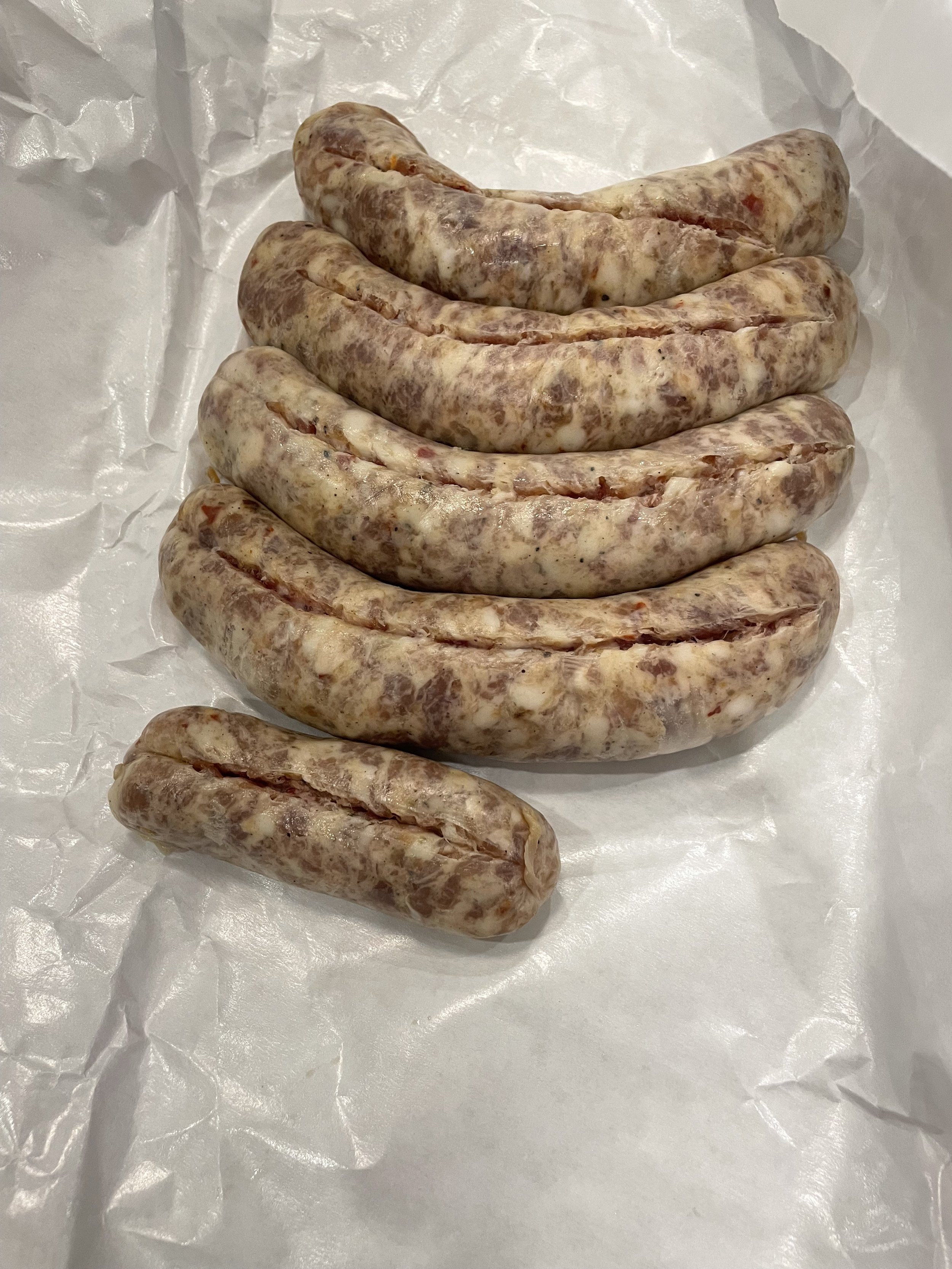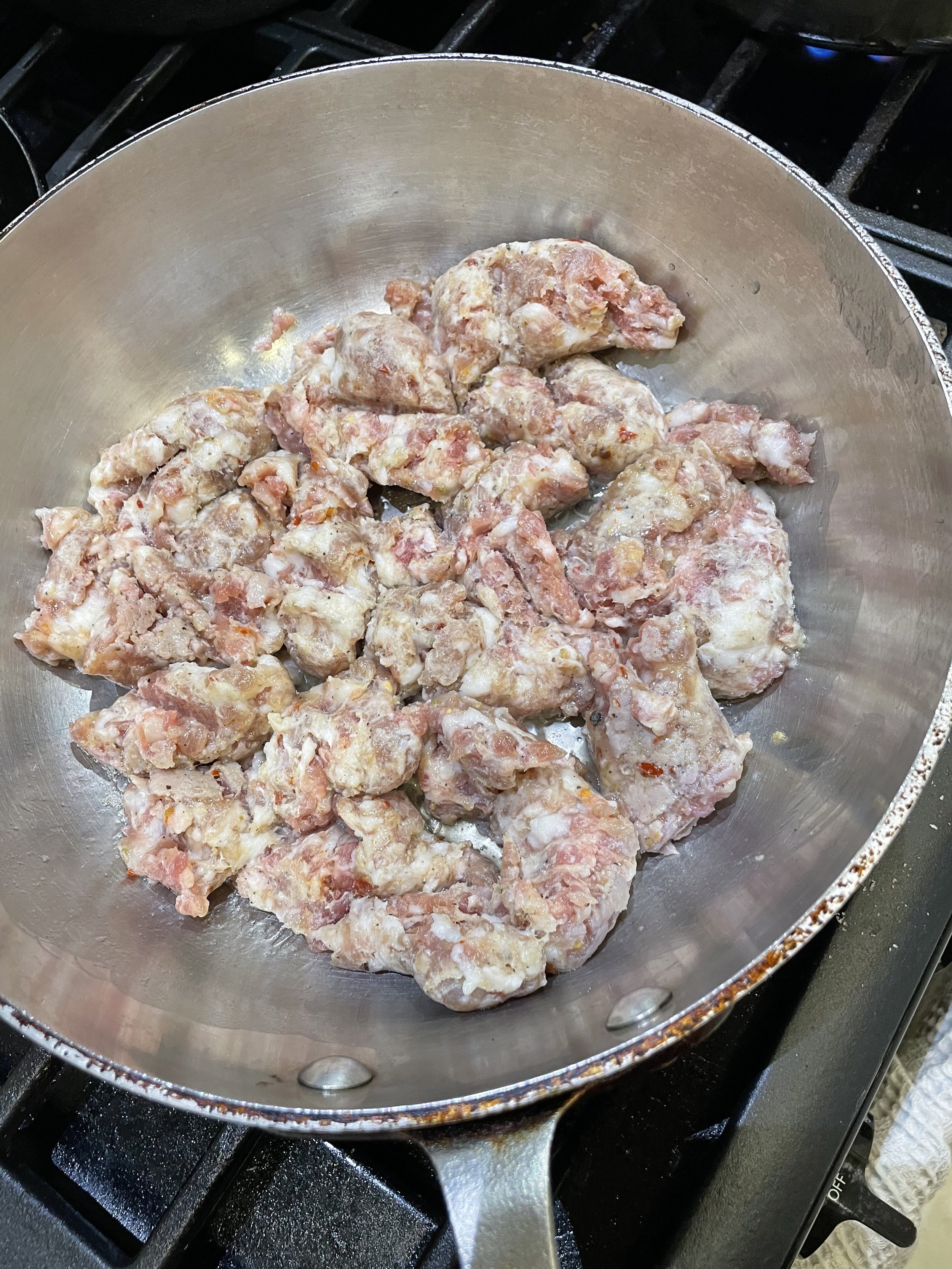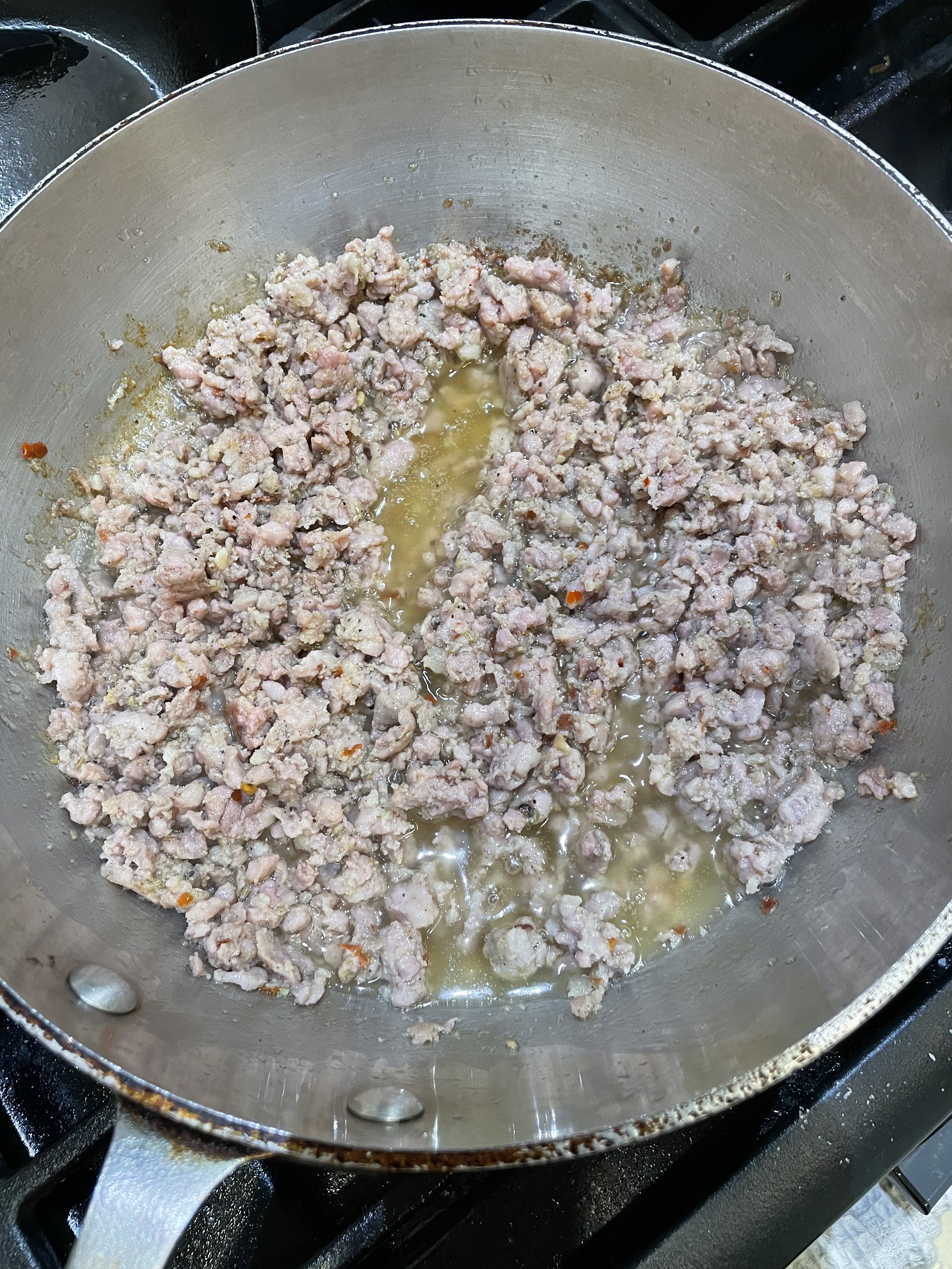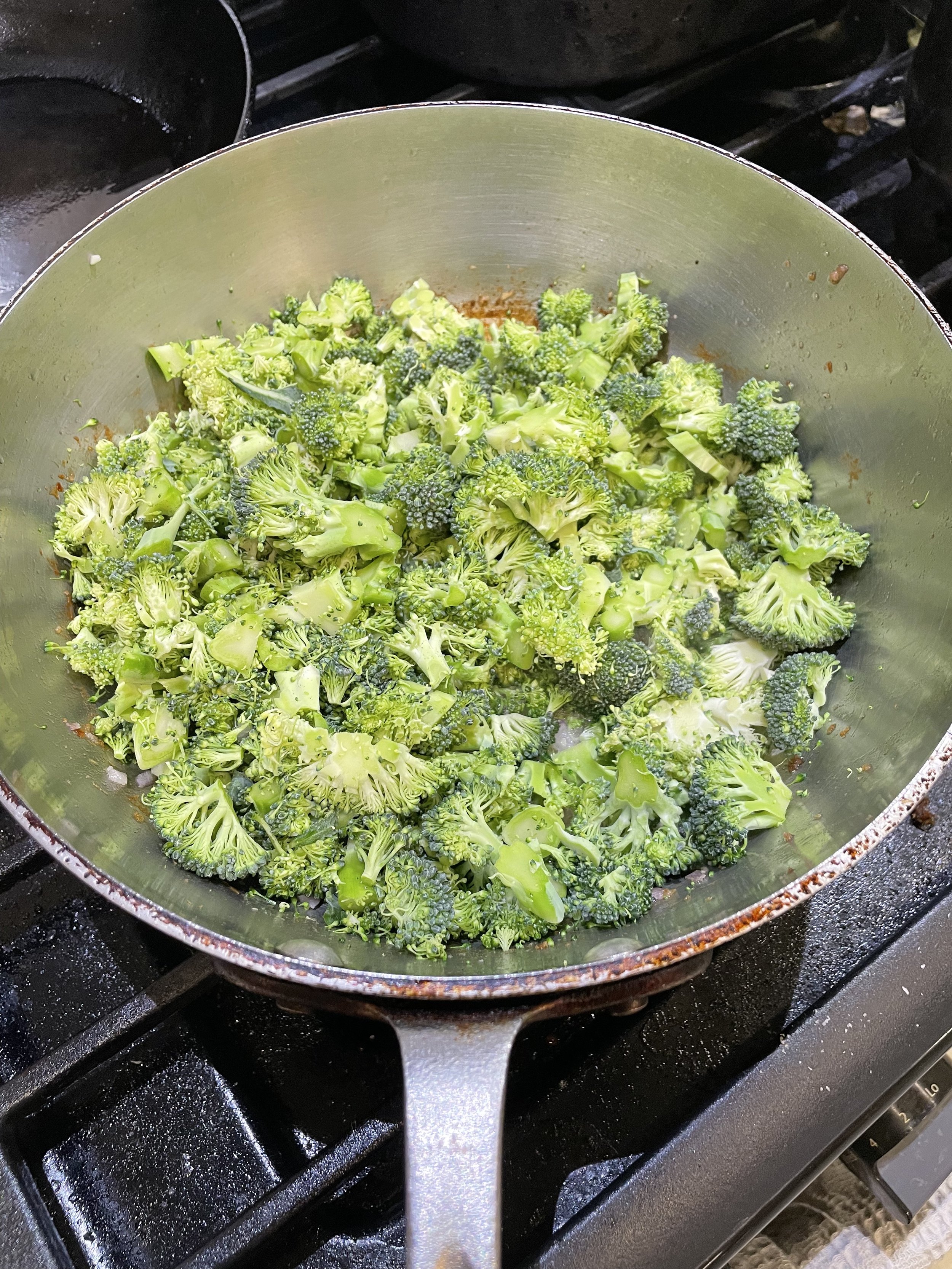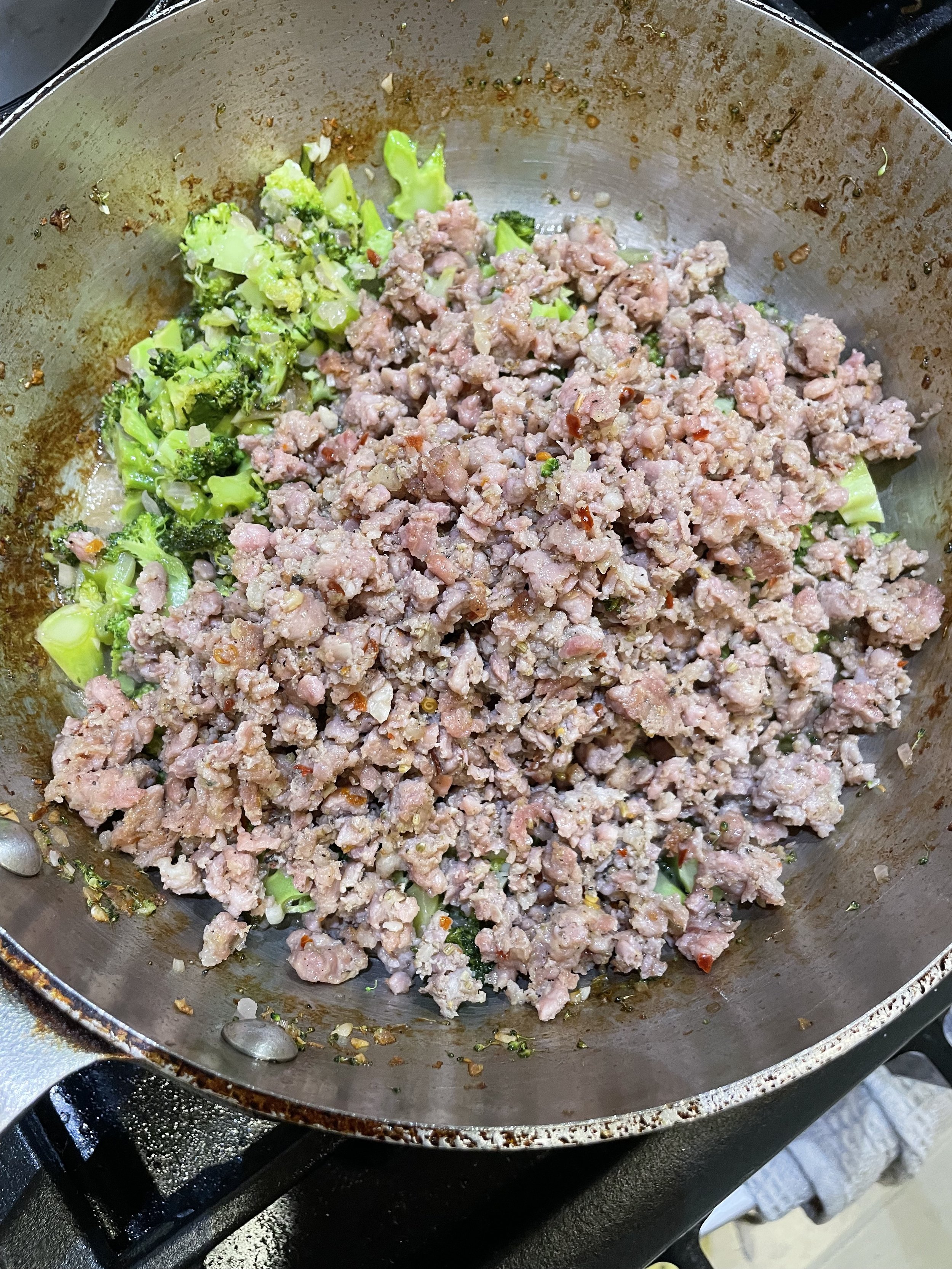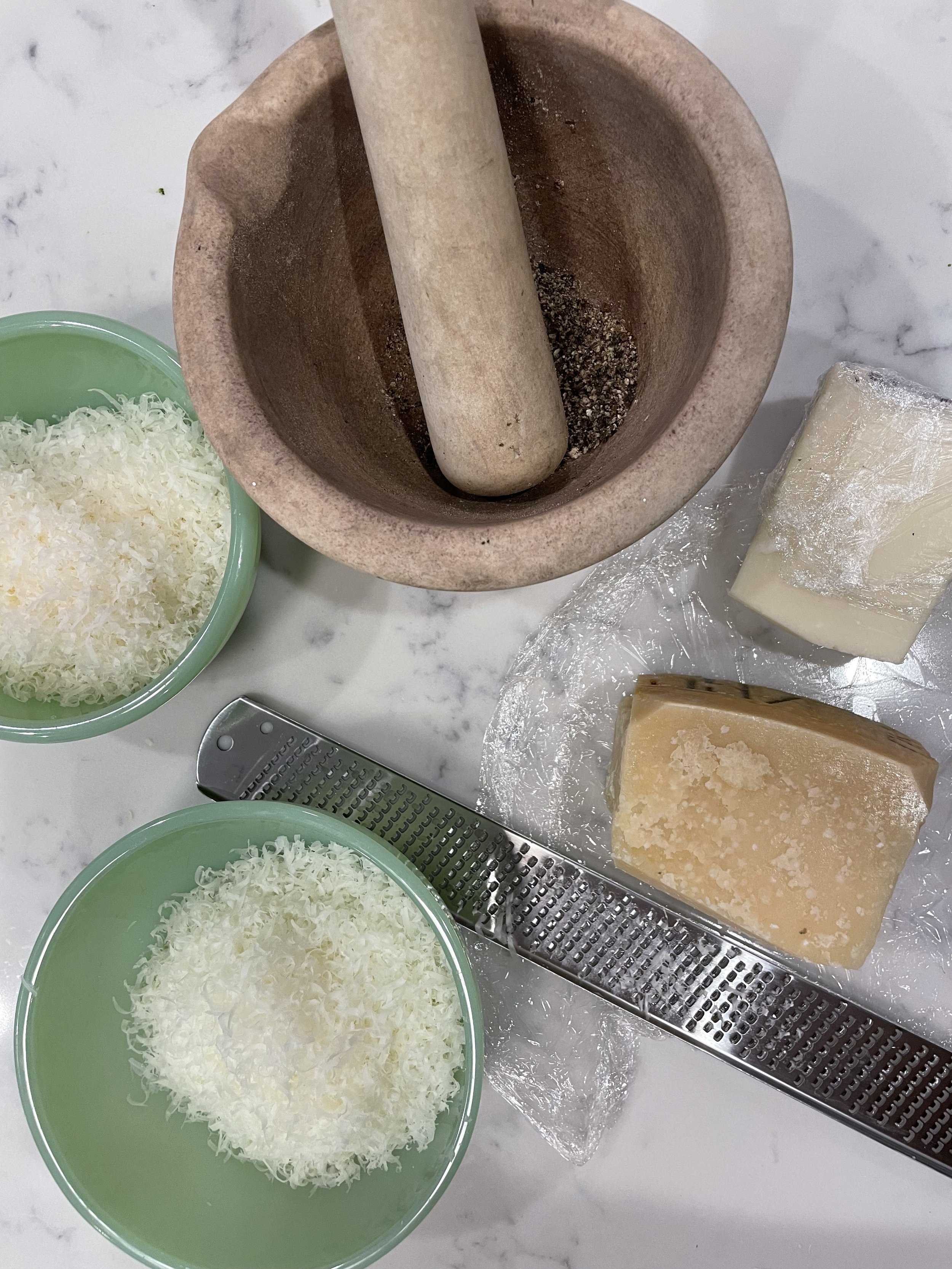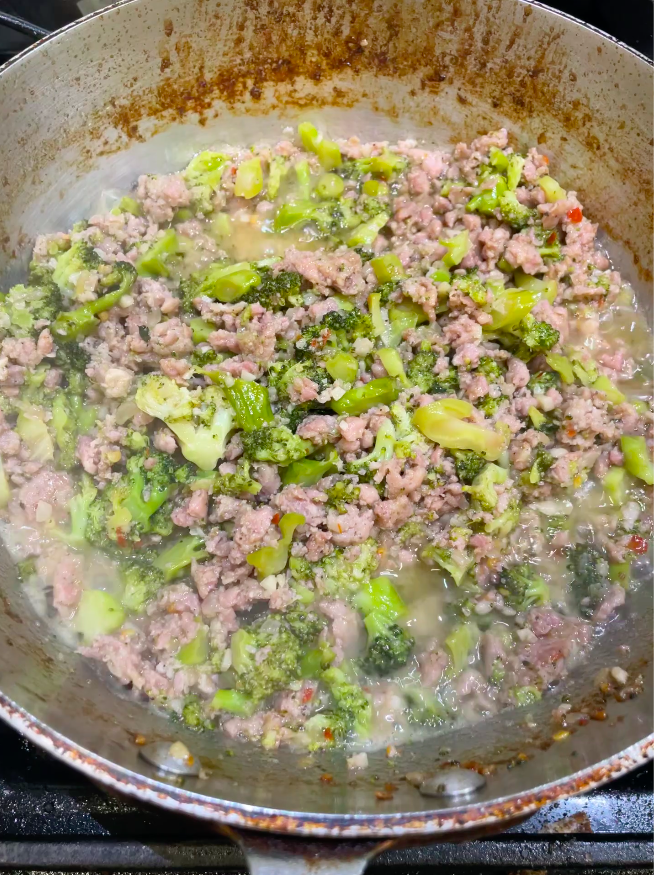What we’ve been up to!
Driftless Weekend 2024 and 2025 - taking the CMC out of Chicago
While the CMC typically focuses on butchery skills, we recognize the value of connecting the dots from the farm all the way to the table. In August 2024 and again in August 2025, we put together a weekend long experience to explore and celebrate the small scale agriculture of a corner of Wisconsin’s Driftless region. Our visits to the region included private tours of Nordik Meats, a small USDA inspected meat processor that services many of the regions livestock farmers. There was an option to view a hog slaughter, conducted by the Humane Handling certified professionals at Nordik, followed by a butchery workshop. In 2024 I led the group through the breakdown of a forequarter of beef. In 2025, Cecka of the Minneapolis Meat Collective and Anna of the Wisconsin Meat Collective did a hands-on workshop on half a hog which they finished by making classic brats. Driftless Provisions, an artisanal salami and smoked meats producer, also featured on both our tours. Co-founder Ryan Wagner showed our group around their processing facility, talked about his journey into old-world meat curing, and put together a tasting of their unique sausages, from their take on finocchiona and smoked andouille to their cacciatore made with elk and their landjaeger featuring bison meat. In 2024, we got a tour of farmstead sheep dairy Hidden Springs Creamery, where we got to tour their cheese making operations, walk through their pastures, taste their award winning cheeses, and play with baby lamb (we even saw and assisted with the birth of twins!). We toured Mastodon Valley Farm, a regenerative multi-species grazing operation with a focus on beef. Rancher and ecologist Peter Allen talked to our group about the ecological history of the region and the ways he uses grazing to restore some of the balance that has been lost since the days when these crowded ridges were oak savannas. On our 2025 weekend, we visited Harmony Valley Farm, a pioneering organic produce farm in the region that grows a diverse array of produce on the valley floor and uses the less-crop friendly areas of their land to raise a small number of beef, hogs, and goats. Farm founder Richard De Wilde walked us through the operation, where we saw recently harvested onions and garlic airing out and visited the hogs who were occupied with some eggplant that were past their prime. We drove down to the tomato, pepper, and eggplant fields where he gave each of us free rein to pick our fill. Both years we celebrated as a group with a big dinner of season, local foods - in 2024 we grilled a variety of butcher’s steaks from a seven year old grass-fed cow sourced from Driftless Prairie Meat Market and ate it alongside perfect Wisconsin peaches, tomatoes, corn, and potatoes. In 2025, we rented the beautiful ridge-top event space at Sittin’ Pretty Farm and were served an absolute feast by Anna and her friends - hand-selected Wisconsin cheese and cured meats, home-made focaccia, salad, corn, potatoes, and carrots (much sourced from Harmony Valley), brats made by our group during the butchery demo, and cuts of pork from the same demo, grilled up with a sweet and spicy peachy glaze.
Keep an eye on our schedule for 2026’s offerings - we plan to return to the Driftless, but will be exploring some other regions as well!
Whole Animal Butchery Demos at Process Expo, covered in Meat & Poultry Mag
This past October (2023), Chicago hosted Process Expo, the biennial convention for meat and food processing solutions such as equipment, packaging, and new technologies. The Chicago Meat Collective was contracted to provide whole animal butchery demonstrations all three days of the convention, to provide a window into the artisanal, hand-cut side of meat processing. On the massive convention floor of McCormick Place, alongside industrial grade meat grinders, brine injectors, and robotic arms that can be programmed to cut meat into precise portions, McCullough wielded a 6 inch boning knife and a 24 inch hand saw, breaking down a whole hog, a whole lamb, and demonstrating sausage making technique in a series of live sessions. Audience members participated in lively Q&A’s after each session, and the industry publication Meat & Poultry featured an article about the demonstrations in their January issue.
There and Back Again
A week and a day ago, I returned from a nineteen day road trip that took me from Chicago, up through Minnesota, North Dakota, into Montana, down through Wyoming, Idaho, and Utah to Arizona, then back through New Mexico, Colorado, Nebraska, and Iowa. The idea to take this trip came to me last fall, when we were wrapping up what I knew would be our last farmers market season. I was looking for ways to expand my horizons as a butcher, instructor, and advocate for responsibly raised meat, and the west, with its history of cattle drives and cowboys and the legacy of the tallgrass prairies and bison herds long since destroyed by colonial expansion and agriculture, was calling me.
Unsurprisingly, Montana, Wyoming, and other states with vast acreage of tallgrass, shortgrass, and mixed prairie, are currently home to some inspiring practitioners of regenerative agriculture (this is a somewhat fluid term that encompasses a vast range of practices, but one definition from wikipedia reads: “It focuses on topsoil regeneration, increasing biodiversity, improving the water cycle, enhancing ecosystem services, supporting biosequestration, increasing resilience to climate change, and strengthening the health and vitality of farm soil.” My personal interest is in farms and ranches that incorporate livestock to achieve these results). One of my goals for this trip was to meet some ranchers, butchers, and slaughter-people who I’ve long admired from afar, and in my planning I landed on Bozeman, MT as a home base from which to explore a tiny sliver of the regenerative agriculture scene in Montana.
The four farmers and ranchers I visited were different in significant ways - one raised goats, one beef, one hogs, and one bison - but they all put soil health on the same level as the health of their herds, recognizing the holistic relationship between the two. Multiple ranchers pointed out the health of their local bird populations to me, signs of a thriving prairie. At Healthy Meadows, a goat grazing operation run by Ivan and Chia and based in Red Lodge, MT, Chia and I chatted about the texture and chemical make up of their goats’ fat, which is highly unsaturated and rich in stearine, much like deer fat and dark chocolate. Ivan pointed out native plants pushing up spring blossoms in his neighbor’s pasture, to which his goats had happily escaped in the early morning hours, as we walked out to round them back up. Ivan and Chia hire out their herd to graze neighboring land as a means of weed suppression, something that the state of Montana requires for somewhat dubious reasons. Goat grazing is a more sustainable alternative to spraying herbicides, and Chia and Ivan are also able to harvest the occasional goat for meat. They are hosts of the upcoming Women in Ranching “circle” in September, which is currently sold out, but worth checking out for future offerings.
At Barney Creek Livestock, Meagan and Pete gave me and my new friends and slaughter professionals Anna Borgman and Jesse Vosler a tour of their soil-focused beef grazing operation. We dug up some earth, talked about worms, irrigation, root structures, and spider webs. It was calving season, and we visited the herd in one of the many pastures they graze around the aptly named Paradise Valley where Pete tagged a new calf, and the herd lovingly followed him around as he chatted with us about grazing practices, watering, and the idiosyncratic personalities of the herd’s elder cows. The next day, I visited Matt at North Bridger Bison, where he takes a low intervention approach to raising bison, mimicking the natural conditions that allowed wild herds to thrive. He takes this approach all the way to the end of each bison’s life - every animal is harvested right there on the ranch, by Matt himself (an accomplished hunter and a sure shot). Because all his animals are harvested in the field and not in a government inspected facility, Matt can only sell his bison by the whole, half, or quarter, directly to consumers who buy the animal from Matt before the harvest. This constraint has not stopped North Bridger Bison’s growth, and only five years into operations Matt freezes and ships his bison nationally, to a strong and growing group of loyal customers who receive a picture of their bison in the field before the harvest, after the harvest, and hanging on the rail at the butcher’s where the meat gets cut and wrapped. I found Matt’s approach and transparency to be a truly winning combination, and I’m trying to find some Chicago-based people to go in on a quarter or half a bison with me, so shoot me an email if you’re interested!
Along the way, I also got to connect with Cecka, of the Minneapolis Meat Collective, and Tom, of the Utah Meat Collective. The world of butchers, ranchers, and slaughter-people who are dedicated to regenerative agriculture is small and dispersed, but this trip gave me a sense of community and easy connection. It was fascinating to drive from spring-time Chicago (where we’d already had a couple 85 degree days), through the thousands of lakes marking Minnesota’s landscape, into the elevated plains of Montana where water is a more scarce and more precious resource. Getting to see the landscape change through my windshield day after day, combined with hearing directly from ranchers about their struggles and their solutions (many constantly in process), helped me begin to see the bigger picture of regenerative agriculture and the way it shows up across different ecologies. I’m already incorporating things I learned into classes I’m teaching at the CMC, and seeing the way ranchers operate out west gave me more perspective on the practices of my old and new favorite farmers and ranchers in the Midwest. Below are some pictures from the trip.
Workshops and Mentorship with the Lee Initiative
The Lee Initiative is a non-profit based in Louisville, KY that fosters “diversity, equity, sustainability and compassion in the restaurant industry” through a variety of programs and grants. In 2021, 2022, and 2023, the Chicago Meat Collective partnered with the Lee Initiative to provide hands-on butchery workshops as part of their Women Culinary and Spirits Program. From their site, “The Women Culinary and Spirits Program creates a path to leadership for women in the food and beverage industry through mentorship, training, and continuing education opportunities. The goal of this program is to elevate more women into leadership positions within the industry with the mindset that doing so brings more equity and diversity to the industry. Mentees are experienced professionals in the early-to-mid stages of their food and beverage careers and are ready to take the next steps towards becoming industry leaders.” The CMC -led workshops covered knife skills, whole animal utilization, and cutting and trimming cuts from all over the animal. We cut local lamb, beef, and pork, and worked on sausage making technique. See videos and photos below from 2021 (workshop hosted by Red Hog Artisan Meat in Louisville, KY), 2022 (two day workshop hosted by CMC in Chicago, IL), and 2023 (hosted by Red Hog).
In 2021, the Lee Initiative invited McCullough of the Chicago Meat Collective to be part of their “Kentucky Week,” for their cohort of culinary mentees. McCullough lead the group of women through an all-day hands-o butchery workshop focused on lamb break down, using lamb from local Freedom Run Farm.
Steak
The burnished surface of a perfectly seared steak is hard to resist, especially one made from high quality beef. Cut from only the tender parts of the animal, cooked à la minute to the diner’s preferred doneness, steaks offer an ephemeral and individual experience. My favorite way to enjoy a steak is alone. I absolutely love a good steak house experience, especially since living in Chicago. I crave a steak (cooked by someone else) and a martini (prepared by someone else) in a dark and lavish dining room (aka anywhere that isn’t my house) as soon as the weather gets cold. And while the dimly glowing walls of a Chicago steak house can provide a great environment to for the meditative experience of eating a steak all by yourself, there’s nothing quite like enjoying a steak at home. It takes a little more doing, but the cooking process becomes part of the meditation. At home, I can fully indulge in solipsism, and I don’t have to stress about what my guests will think if I don’t get the cook quite right. It’s probably for that reason that my steaks always come out best when no one is watching.
There are many schools of thought on how to achieve the best steak at home. Some of them involve equipment like a sous-vide or a searzall (basically a blowtorch), some say a simple reverse-sear (starting in the oven, finishing on the stove top) yields the best steak. All of them have their benefits, and if you’re cooking a two inch thick bone-in ribeye, you’re going to need to use some of those techniques to avoid smoking out your house and standing over your stove for 45 minutes.
But that’s what’s so great about steak for one - it’s as simple and satisfying as it gets. Start with a steak cut between 1-1.5”. Season both sides with kosher salt about 45 minutes before you want to eat. Prep a salad, or a martini, or some shrimp cocktail while your steak absorbs the salt. After about 30 minutes, place a cast iron pan on the stove and turn the heat all the way up. Pat the steak dry with some paper towel. Once the pan is hot, add some tallow or ghee (both are clarified and can handle high temperatures), and then add your steak. Use a metal spatula to press the steak down so the surface is evenly in contact with the hot pan. Flip it often. Maybe add a little more fat and baste it towards the end. For medium-rare, the whole process should take about 5-8 minutes. Rest your steak another 8-10, pour that martini, plate your salad, and dinner (or lunch…or breakfast) is served.
Suadero
When I was growing up, Mexican food was not a part of my culinary world. My exposure to it was mostly through the Taco Bell commercials with the talking chihuaha - which is to say I only really remember Mexican food existing in the forbidden realm of American fast food. I remember a couple times when my mom, craving something new and brave enough to try it, brought home hard taco shells and all the other fixings - ground beef, lettuce, shredded cheese. As we sat around the table scooping ground beef and shredded lettuce into bright yellow shells, it was clear to me that we weren’t doing it right. The shell, hard but not crunchy, the beef, warm and barely seasoned, the cold lettuce, and the dusty low fat shredded cheese communicated only one thing to me - that I was missing something. A good bite of food can connect us to another place, another person, a culture. These American flavors had had no place in my childhood palate and they didn’t point towards Mexico. The empty signifier of the taco shell broke at the seam, spilling ground beef out onto the plate.
In the years since those hard-shell tacos at home, I’ve been lucky to try a lot of Mexican food whose flavors have expanded my palate and sparked my curiosity. A lot has also changed since the mid-90s as the forces of globalism, immigration, the internet, and foodies have pushed chefs into the spotlight and culinary exploration into the realm of mainstream obsession. The taco is widely written about, documented, and Netflix-ed, and they’ve actually become a staple of my family’s holiday meals (now we use fresh corn tortillas, and slow cooked beef among other things). These days it’s not so eyebrow raising to call a good taco transcendent. So in the name of transcendence, of being more than the sum of one’s parts, I want to talk about suadero. A specialty of Mexico City, suadero is made from tough and fatty beef, traditionally from the chest and belly of the animal. It’s salted, and cooked simply in water and animal fat. At a traditional street taco stand you would see hunks of suadero bubbling away next to tripe and longaniza sausages in the well of the choricera comal, the juices and fats of the different meats melding and flavoring one another. The taco itself is simple, a small corn tortilla or two lubricated with fat and warmed on the comal, a pinch of chopped and crisped suadero, chopped onion, cilantro, a dash of salsa.
I’ve only had suadero from one taqueria, and it’s the one at La Chaparrita in Chicago where I live. A beloved, Mexico City style taqueria with a simple menu, La Chaparrita’s suadero is tender, unctuous, and beefy, with slightly crisped edges. From the first time I tried it I wanted to see if I could recreate it, not because I thought I could come close, but because it got me excited about a new way to cook beef. I took a cue from another Mexican favorite, pork carnitas, and I approached making suadero for the first time right after butchering a side of beef. As I was cutting and trimming all the familiar steaks and roasts, I saved all the meat from the belly that might otherwise get trimmed and ground. I threw some salt at it, and let it sit overnight. The next day I submerged the seasoned beef in tallow I had rendered from the same animal, and simmered it for about two hours until it was tender. I have barely changed the recipe since that day, and while I highly recommend any Chicagoans head to La Chaparrita and try their suadero asap, I am so excited to be selling suadero on our online store by the pint. Here’s how I like to use our suadero, though once you crisp it up you can really put it on anything:
Broccoli e Salsiccia
I wanted to share some food memories, musings, and recipes with you all, and I’m going to start with a recipe for orecchiette with sausage and broccoli, which I love to make in any season but especially the winter time and especially with our spicy Italian sausage. I don’t remember the first time I had this dish. There’s something so obvious about the flavors and textures it combines, something ultimately comforting, that makes it feel like it’s been your favorite food forever. In high school, I was an isolated teacher’s pet living in a tiny rural Connecticut town, going to a very preppy boarding school as a day student, which meant that every night after mandatory sports practice I got picked up by my parents, while all the other girls stayed up in the dorms watching gossip girl and doing each other’s nails (this is how I imagined they spent every night). I was a fiend for languages and got roped into the Latin department which was under-enrolled, and I decided that since I was just spending every night doing mountains of home work and watching Law and Order with my parents (evenings I’m so grateful for now), I would take advantage of the study-abroad program. I spent an entire school year in Viterbo, Italy, studying Latin and Italian and getting introduced to the home cooking of Rosanna Fringuelli, my host mother. I don’t remember if she ever made this dish, but she made many other incredible pastas all of which nailed that casual Italian flair for a perfect emulsion of pasta water, finely grated hard cheese, and fat from olive oil, pork, or both. That emulsion is part of what makes orecchiette with sausage and broccoli greater than the sum of its humble parts, impossible to stop eating, and so fun to cook.
Here’s how I love to make it:
Start with high quality orecchiette pasta, a shape that recalls a little ear, native to Puglia in souther Italy. I like the brand Isola. In recent years I’ve gotten really into weighing out my pasta because I turn into an eating machine who knows no limits when faced with a bowl of pasta. I like to do 80-100 grams per person, depending on my (and my guests) appetite. I will say this pasta makes incredible leftovers, unlike almost any other pasta dish, and it’s one of the only leftovers I will eat cold, shamelessly.
To serve two hungry adults with some leftovers:
250g orecchiette
1 pound spicy italian sausage, bulk, or casing removed.
Florets/crowns from 1 large bunch of broccoli cut into bite size pieces, about 3/4 pound
1 shallot, minced, or 1/2 a yellow onion minced
3 cloves garlic, minced
3 ounces of finely grated (or microplaned) parmigiano
3 ounces of finely grated (or microplaned) pecorino romano
4-6 ounces dry white wine
Kosher salt
Fresh ground black pepper
Start with a heavy bottomed sauté pan or cast iron skillet (I do this in an all clad saucepan like this one). Place the sausage meat into the cold pan, turn the heat to medium, and use a metal spatula to break up the sausage. Keep breaking it up into small crumbles, and keep it moving - a little browning in the pan is ok, but we’re looking to cook the sausage through gently. When it’s fully cooked, remove the sausage from the pan and set aside in a bowl. Add the minced shallot/onion and garlic to the pan, keeping the heat medium. There should be some fat and liquid from the sausage left in the pan, but if you need a bit more add a tablespoon of olive oil. Sweat the onions and garlic for about 1-2 minutes, then add the chopped broccoli, a pinch of kosher salt, and toss a few times. Cook for around 2 minutes, tossing occasionally, and then add the wine. The wine should simmer, so turn up the heat if necessary. Cook, stirring occasionally, for five minutes and then turn the heat to medium low and loosely cover the pan. We want the broccoli to cook til soft - it won’t hold its vibrant green color, but that’s ok! It will become a comforting muted green. In the meantime, fill a pot with water for the pasta, add a big pinch of salt, cover with a lid and bring up to a boil. Once it boils, add the pasta and cook according to the package instructions until al dente. When you add the pasta to the water, add the sausage back to the pan with the broccoli. We’re looking for a melded mixture with a touch of moisture to coat the pasta, but nothing soupy or too saucy. Once the pasta has been cooking a few minutes, use a ladle or big spoon to scoop about 1/4-1/2 cup of pasta water into the pan with the broccoli, keeping the heat medium, to meld the broccoli and sausage.
Strain the pasta. Add a couple pinches of the parm and pecorino to the broccoli and sausage mixture, reserving rest for garnishing the individual bowls. Taste the mixture for seasoning, and then toss the orecchiette into the sausage pan, stirring to incorporate. The little ear shapes should cup the tiny crumbles of sausage and broccoli florets. Serve in a deep bowl, with a sprinkle of each cheese and a dusting of fresh ground black pepper. This goes so well with a cold glass of Italian white wine like the Sikelè Bianco from Cantina Marilina.
Share Guides - Beef
When we first started the meat shares in the spring of 2020, I asked my friend Nick Murway - who took all the beautiful photos you see on our site - to help design a guide to help customers confidently unpack their shares and make the most of each cut. Click the photo to download the beef chuck share guide! We now offer whole beef shares, rather than just beef chuck, but the design and the tips remain worth checking out!
Meat Share Program Featured in Foodtank
Learn more about the meat share program, why I started it, how it attempts to respond to the pressures that the pandemic has put on conventional meat processing, and more in this article written by Chicago resident and CMC supporter Kim Behzadi. Click here for the full article.
Private Classes featured in Chicago Magazine Fall 2020
You may have heard that we are offering private classes for small groups - in fact you can learn more now by navigating over to the “what we do” tab and clicking “private sessions.” We are honored that Chicago Magazine included us in their fall roundup of adult education opportunities! Visit the article here.
Newcity Magazine writes up Chicago Meat Collective
Read about our project in Chicago’s Newcity Magazine, which you can pick up at coffee shops and bookstores around the city, or read the article online here.
McCullough competes on History Channel’s “The Butcher”
You can catch our founder McCullough Kelly-Willis on the History Channel’s new competition series “The Butcher.” In this show four butchers face three diverse challenges, with one getting eliminated every round! See how McCullough does, the episode is now available to stream. https://www.history.com/shows/the-butcher/season-1/episode-4





